








The craftspeople at Espinoza’s Leather Company in East LA have been fabricating custom riding gear one garment at a time by hand since 1971. The Biltwell + Espinoza vest is built tough to survive a lifetime on two wheels. Exterior construction features 14-ounce black canvas and UV-treated cowhide trim with poly/cotton stitching throughout. Other details on this limited-edition original include hidden snaps, plenty of pockets, and a dependable brass zipper. These vests were made in a limited quantity and are only available on our website – www.biltwellinc.com

Picking the perfect saddlebags for your custom big twin adventure bike just got easier. EXFIL-36 and EXFIL-18 drill your choices down to two
Choosing the perfect motorcycle luggage system is tough. Hard cases are expensive, and their smooth painted surfaces make them less than ideal for lugging extra gear like bedrolls and tents. Lockable adventure boxes are rugged, but their tin shed construction looks agricultural on FXRs, Dynas, and Softails. EXFIL saddlebags fill the gap perfectly. Both models feature ballistic-grade synthetic materials and hand-crafted construction to create saddlebags that work hard and look great. Like every piece of moto luggage in our line, EXFIL saddlebags are engineered for universal fitment and easy installation on a wide range of custom motorcycles.

EXFIL saddlebags come in two sizes: 36 and 18. Their names refer to the number of 12-ounce cans each bag can hold—36 per bag for the large set, 18 each in the small pair. Both systems include a mounting yoke with Velcro panels for adjustable fitment and heavy-duty nylon zippers for fast detachment after the ride. MOLLE on the exterior provides lashing and expansion points so you can haul more gear on long rides. Two snug, waterproof nylon covers included with each set will protect your gear when Mother Nature changes your game plan.

WHO SAYS YOU CAN’T TAKE IT WITH YOU? NOT EXFIL-36. THIS SET UP HOLDS EVERYTHING…



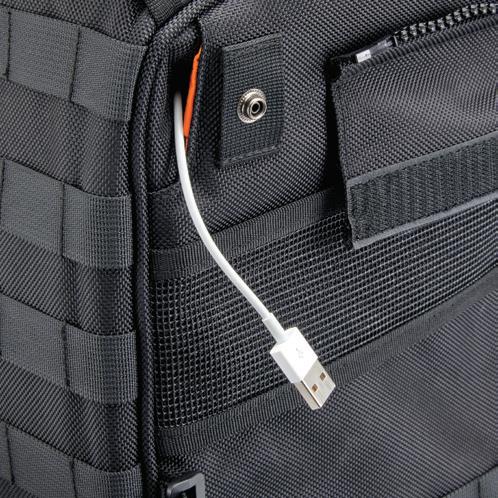




Multiple D-rings, MOLLE points, and high-strength nylon loops provide options for carabiners, bungee cords, etc.
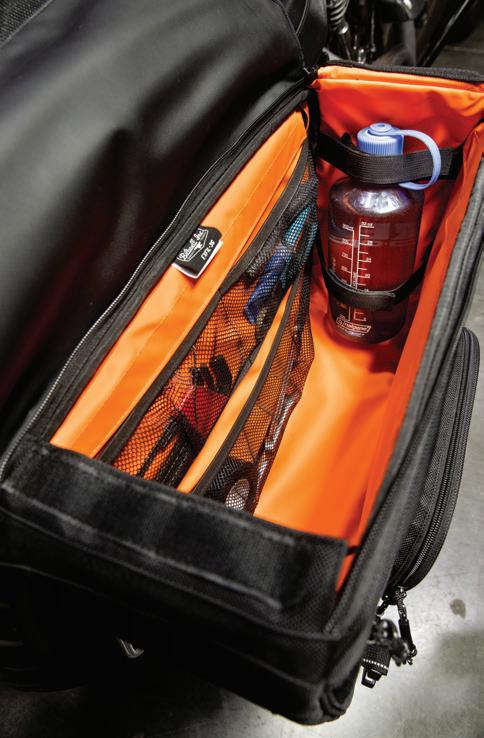
Our first full-sized saddlebags are the last word in utility and style for motorcycle adventure. Each hand-crafted bag provides interior volume equal to 36 12-ounce cans. That’s 72 Silver Bullets for the pair—more than enough capacity for your next long-term bugout. MOLLE on the exterior lets you expand load capacity with aftermarket accessories and strap down loose gear. Our yoke mounting system installs over the rear fender and under the

seat on most Harley-Davidson motorcycles, but universal fitment means EXFIL-36 will practically fit anything on two wheels if you’re motivated and clever. We engineer every piece of EXFIL moto luggage to be rugged and reliable, and EXFIL-36 is no exception. From its heat-resistant canvas bottom to the paracord pulls on its heavy-duty nylon zippers, every mil-spec textile, rust-proof buckle and hand-crafted stitch is built for toughness and years of reliability.



Zippered clamshell cover closes securely with two 1.5-inch wide (36mm) reflective polyester straps and Duraflex quick-release buckles


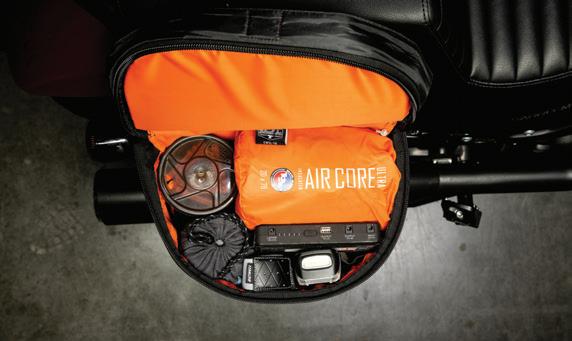
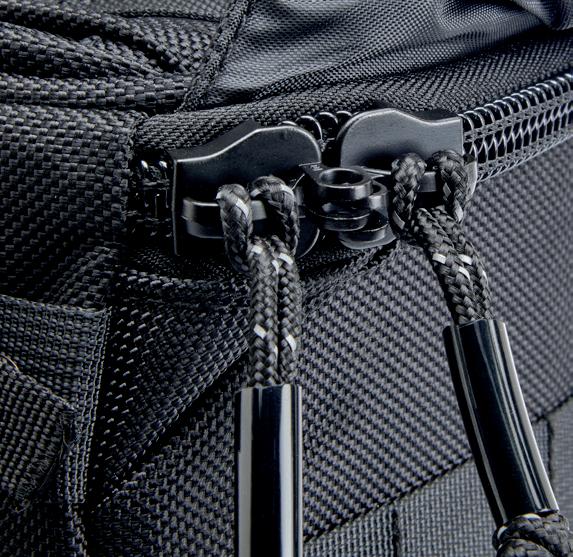


provide extra protection in extreme conditions
MOLLE system provides options for attaching extra gear and accessories
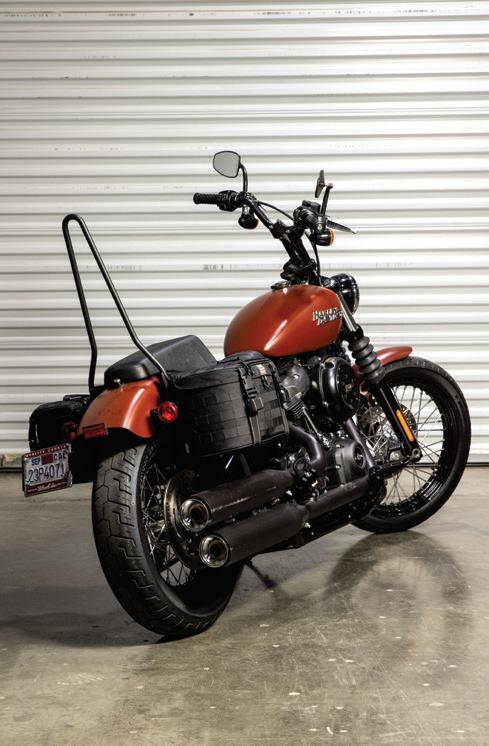
EXFIL-18’s visual similarity to our EXFIL-7 is no accident. Fast movers and light packers have been strapping our original motorcycle utility bag to fender struts on Dynas, Sportsters, and FXRs for years. Building a set of larger, more structurally robust and feature-rich bags that mimic EXFIL-7’s silhouette was a no-brainer. Like its larger stablemate EXFIL-36, EXFIL-18 saddlebags hang under the seat and over the rear fender on an
10” wide x 8” deep (254mm x 203mm) zippered pocket on clamshell top
UV-treated 1680-denier ballistic nylon resists moisture and fading

easy-to-install yoke with Velcro adjustment. To keep the bags from rubbing against drive chains, belts and brake rotors, we recommend installing a set of aftermarket saddlebag supports on your motorcycle. EXFIL-18 offers half the volume of our full-sized EXFIL-36 saddlebag, but handles business with the same smart design and rugged construction features as every bag in our moto luggage stable.
Strong, flexible EVA foam panels inside main compartment for structure and durability
Multiple D-rings and MOLLE points provide options for carabiners, bungee cords, etc.
Chris Lacy: “Trailers are for boats. EDR is for choppers.”

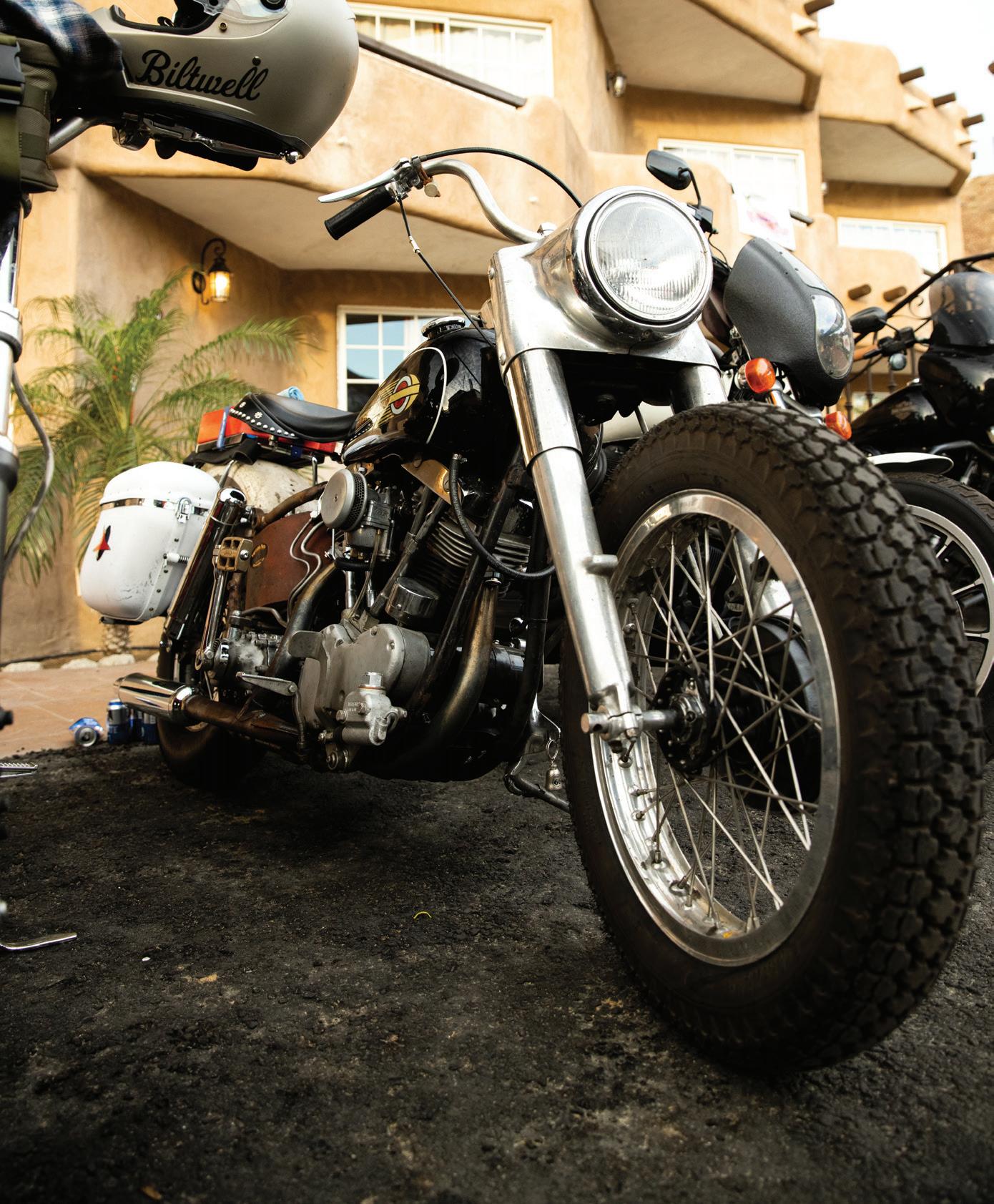

The EDR has always been open to any rider on any bike, but the run was designed specifically with hand-built choppers in mind.
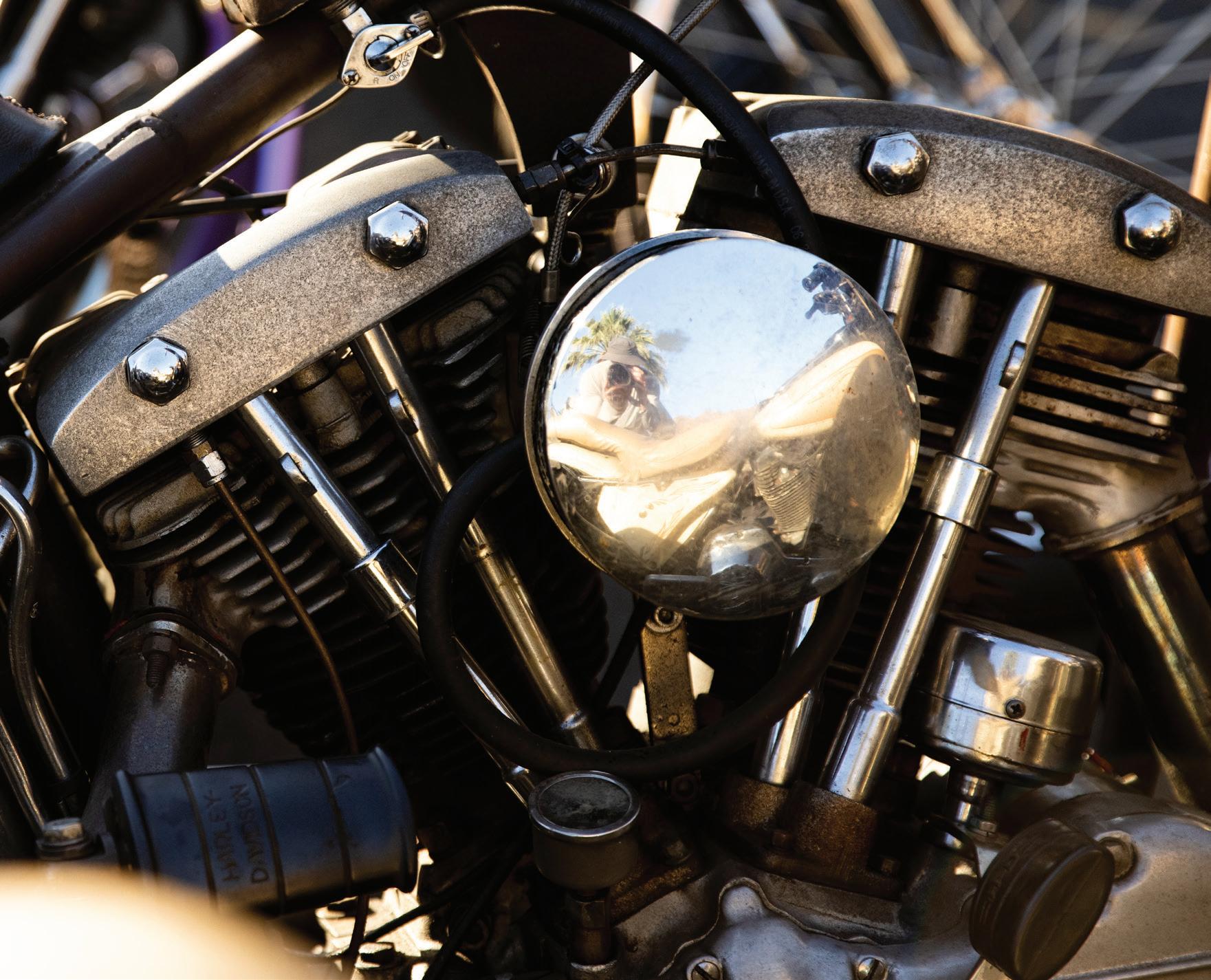
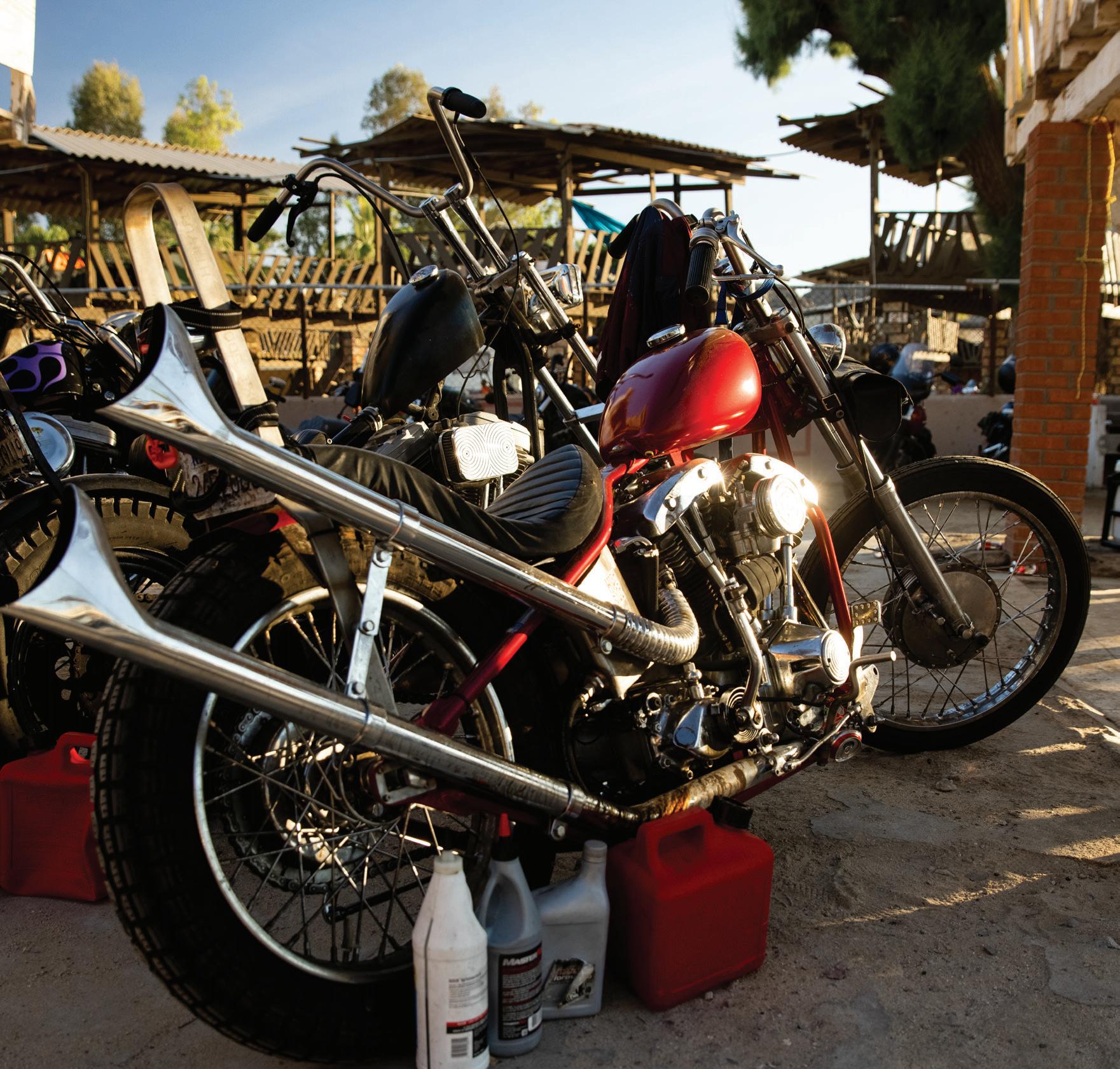
The inaugural El Diablo Run attracted a rogue’s gallery of choppers—anything the three dozen or so home and pro builders who crossed the border that first time in 2006 could have imagined. As tastes in custom bikes evolved, so too did the hand-built machines that flocked to Baja each year.
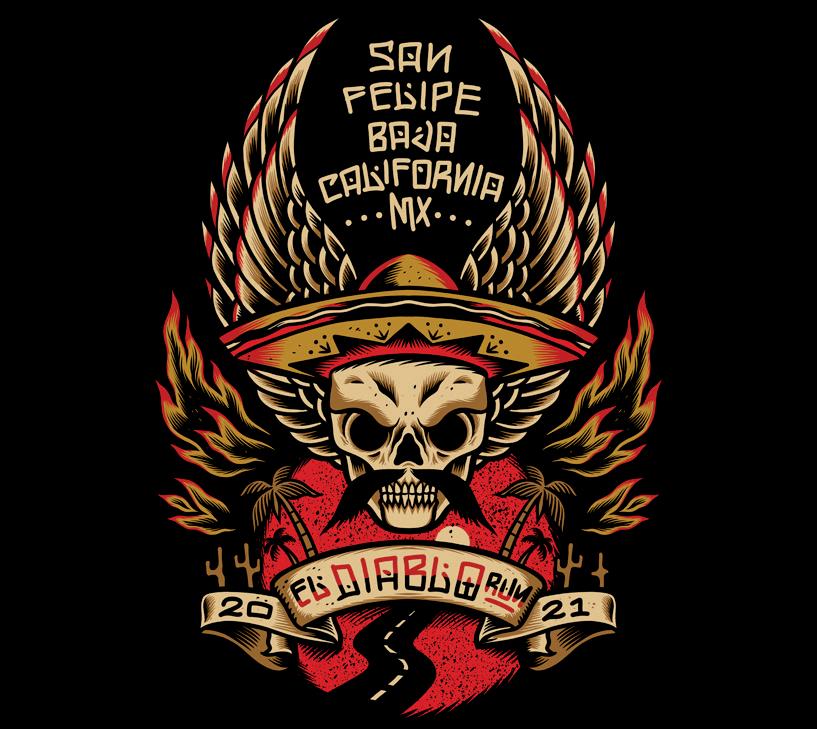
While plenty of baggers and Dynas now participate in the bi-annual parade, hundreds of custom metric and American machines still make the pilgrimage to San Felipe. Now as always, El Diablo Run is a celebration of custom motorcycles and the people who build and ride them. Ladies and gentlemen, these are the choppers of the 2021 El Diablo Run.



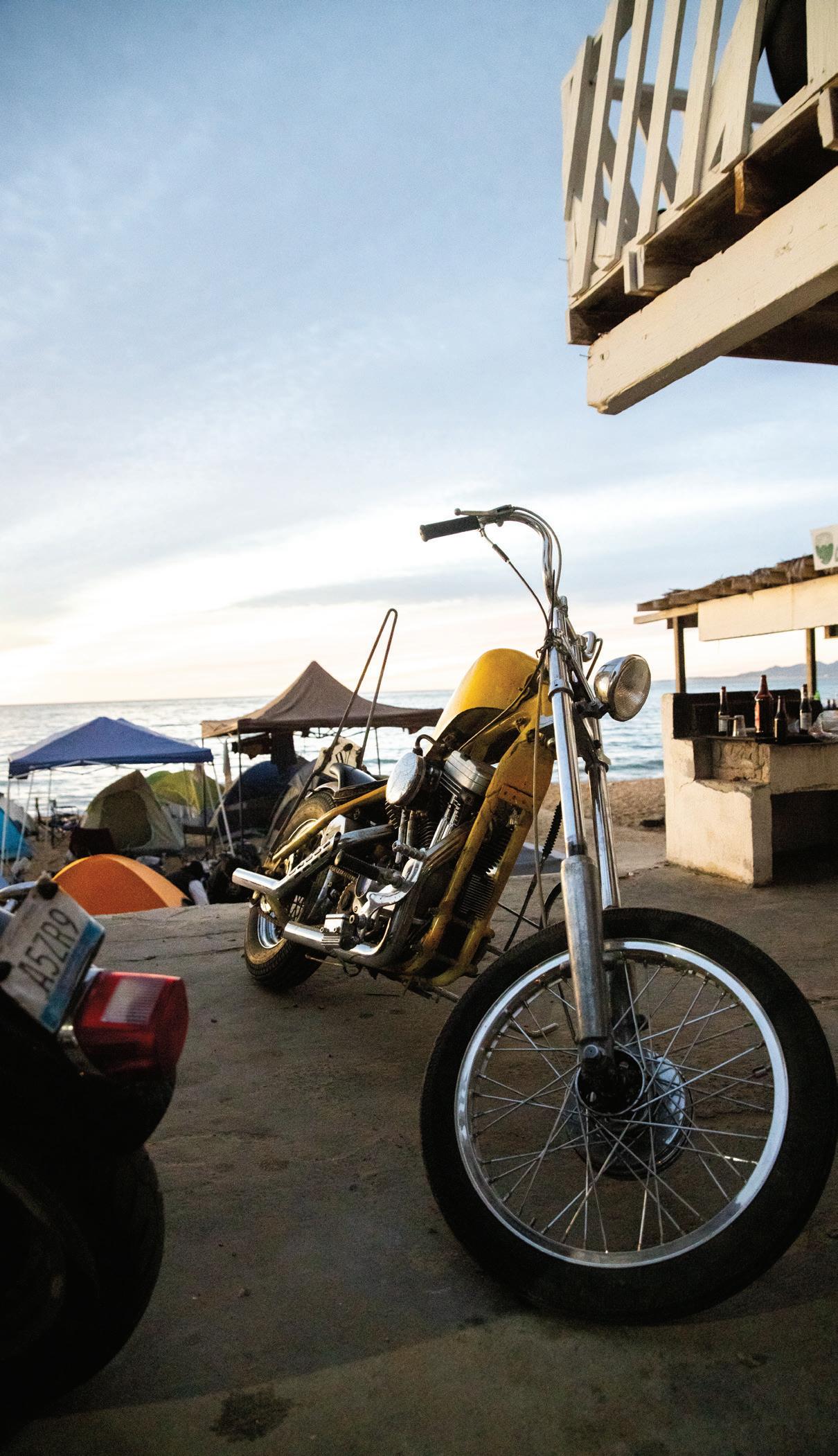

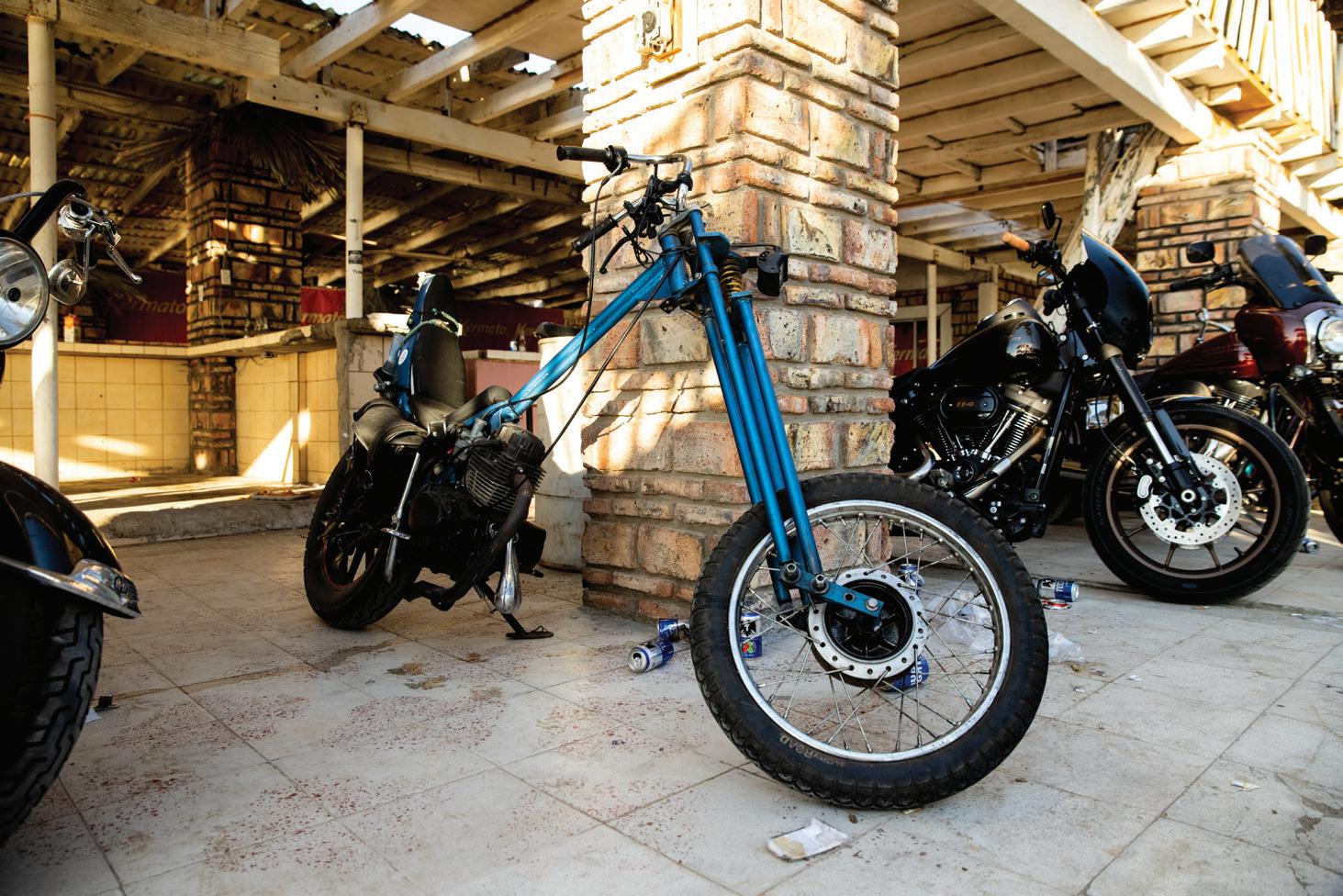
Fred rode this shitbox, hand-made 150cc single chopper thingy with a gas tank for a fender for days to get from his home in mainland Mexico to San Felipe. It wasn’t his first attempt, but was his first successful one. He got the hard ass award of course. Follow him on Instagram: @barba_negra_metal_works

M.O. hates the internet and is going to be pissed at us for showing his bike here. But we’ll do it anyway because we love it, and him.

Hardy souls that ride and wrench on old bikes still exist in the world and the EDR never fails to brings ‘em out.

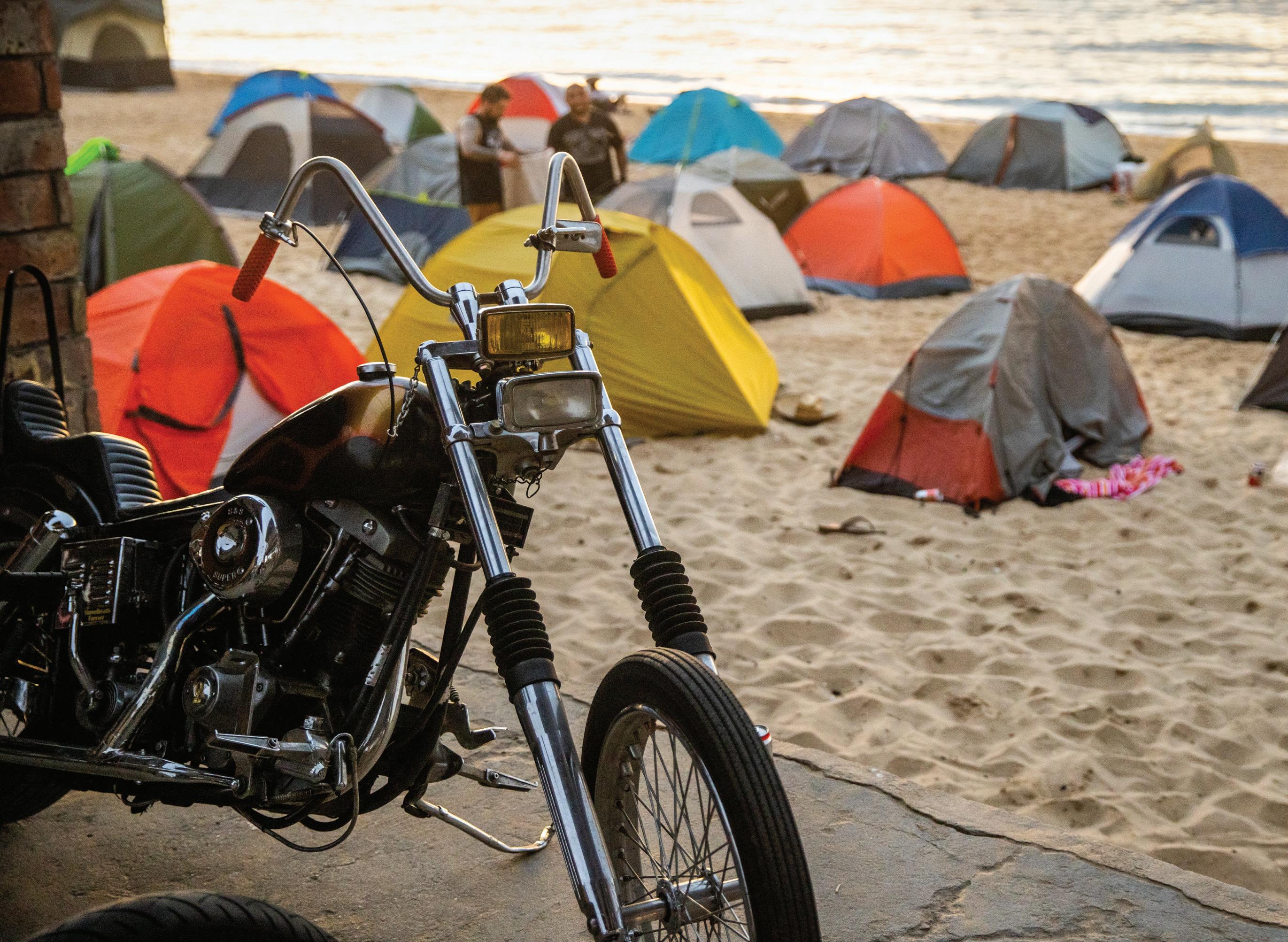
Big twin Evo powered chop. Nothing wrong with fast and reliable!
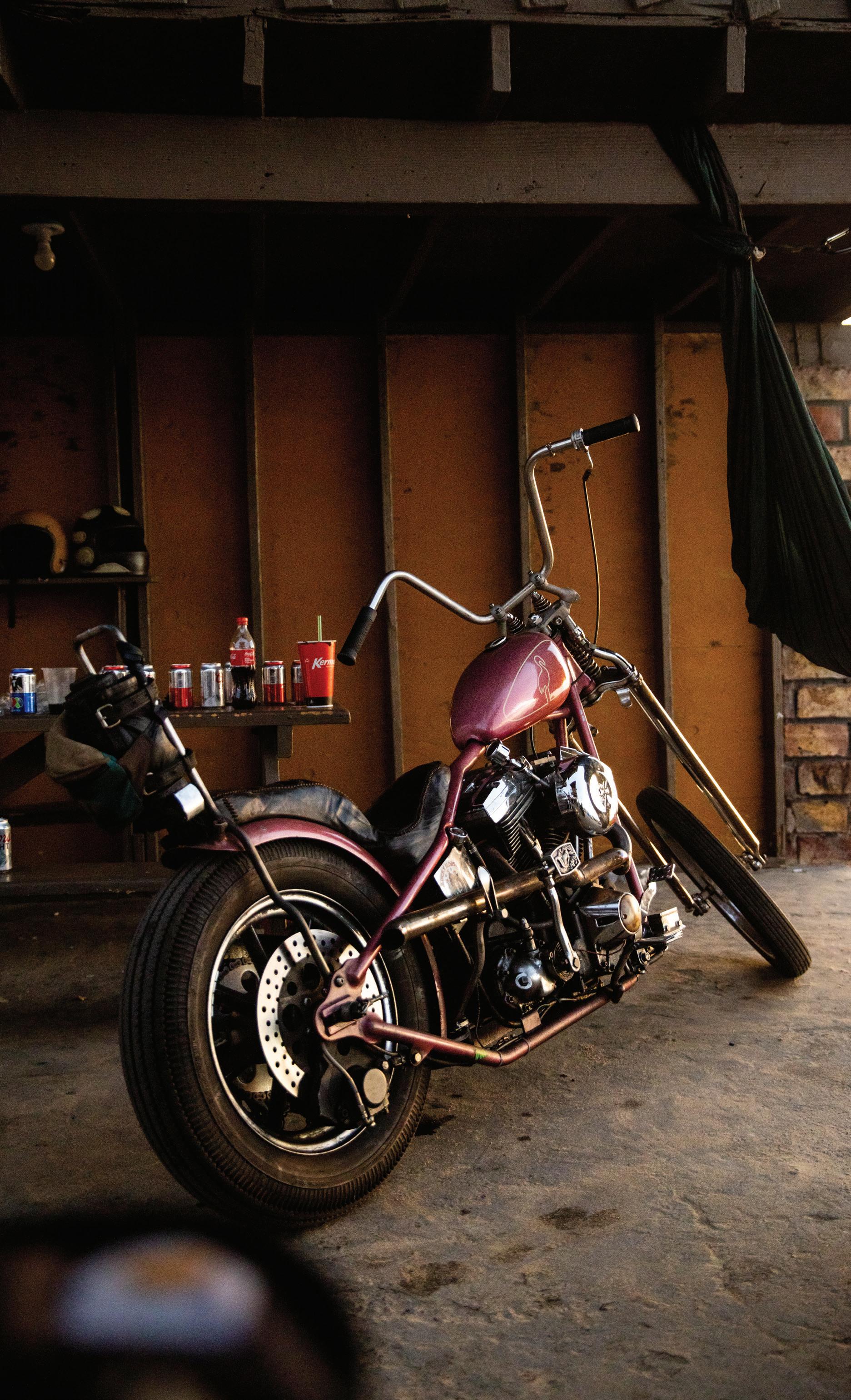
Below: AZ Nick’s hot rod shovel he rode from Phoenix. The bike did great, but he was sick for weeks after the run.
Choppers Magazine editor Carey Brobeck hasn’t missed an EDR since 2008. All of ‘em on this black panhead chop.




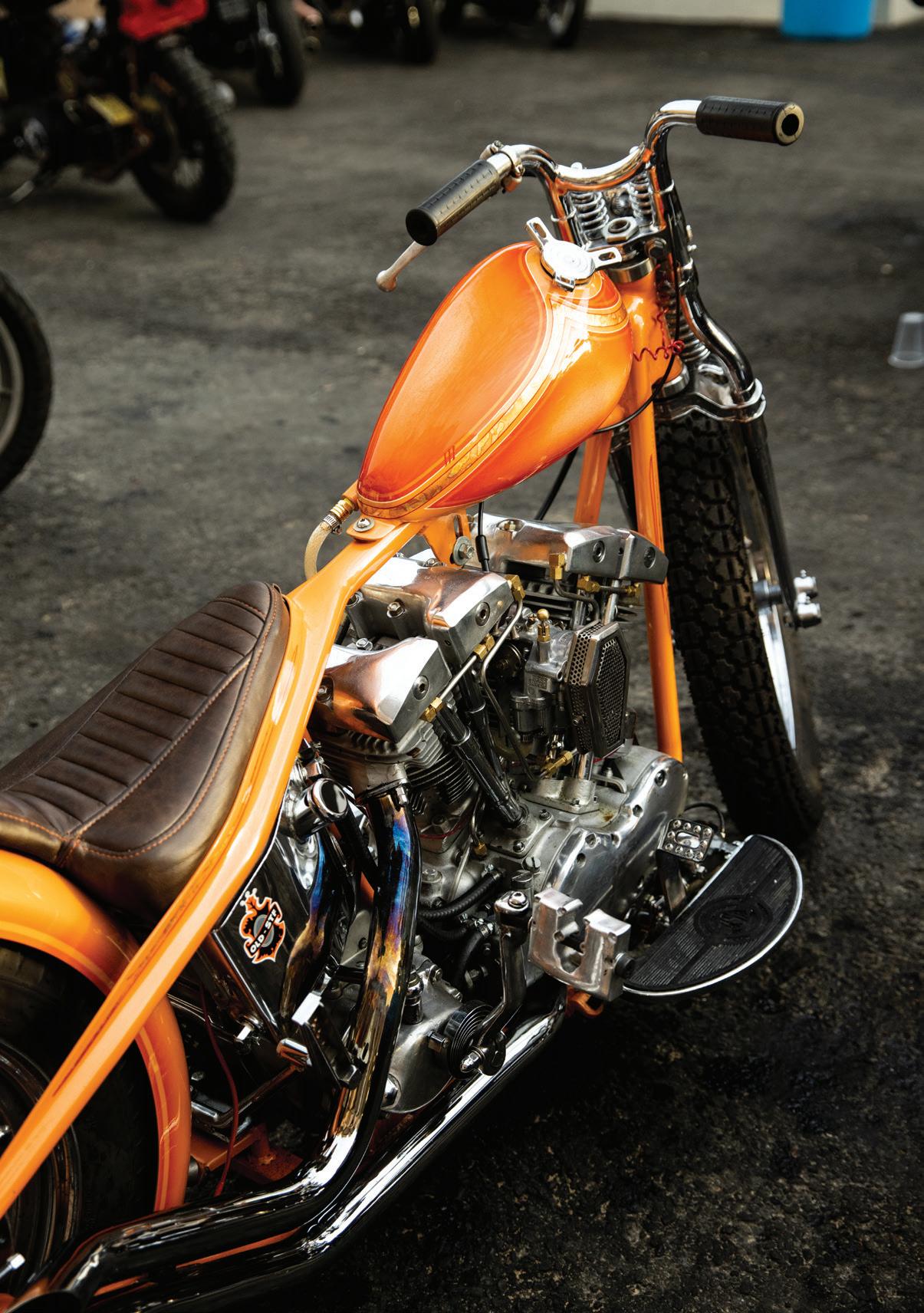

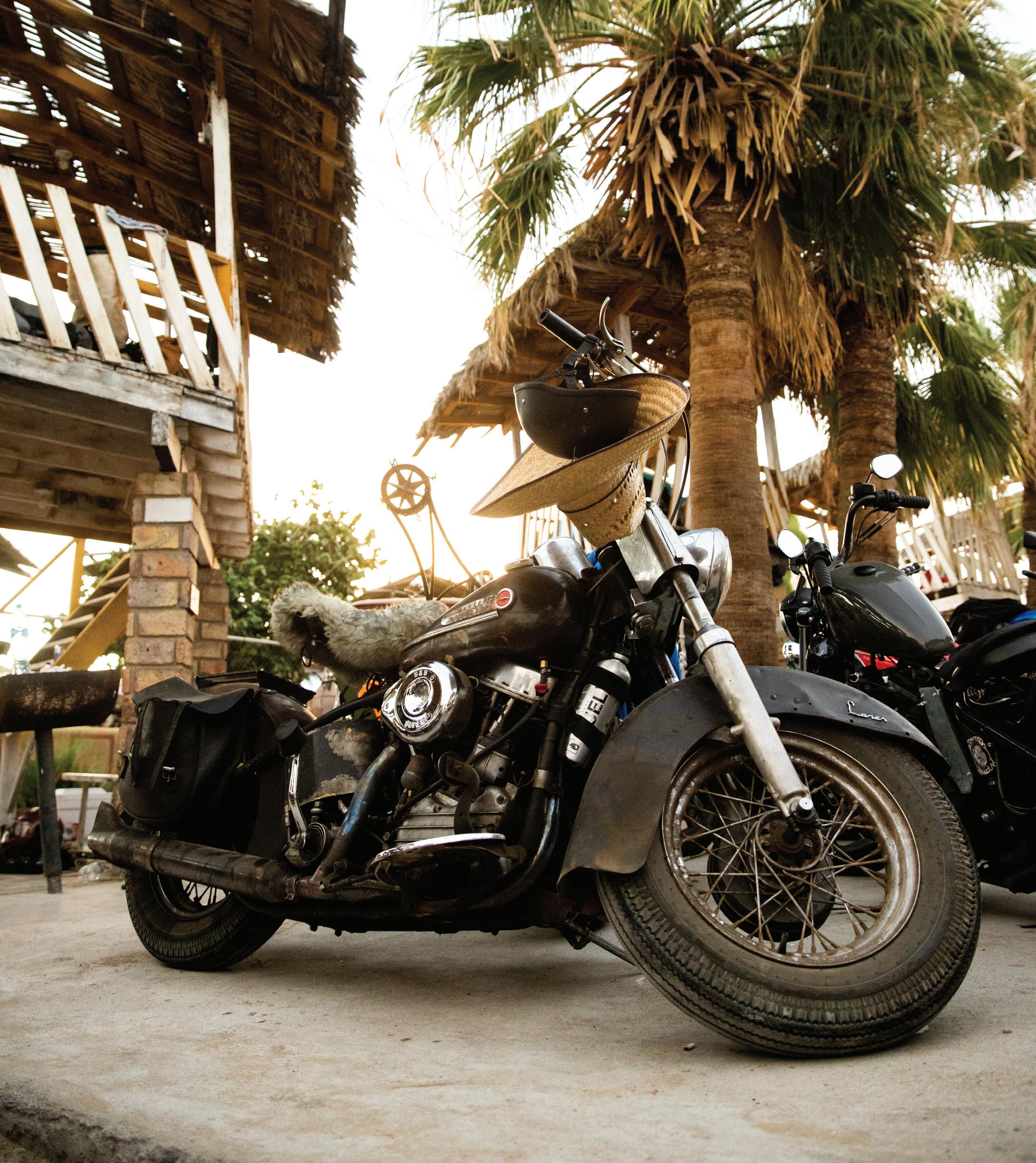


We’ve made hard parts for Harley-Davidsons since day one—everything from pegs and seats to bars, risers, and grips. When The Motor Company introduced their M8powered Softail in 2018, we dropped a full range of high-performance bolt-ons to make Harley’s newest cruiser more stylish and easier to control during high-stakes riding.
Engineered to improve ergonomics and handling, Biltwell Tracker bars and Murdock risers are a smart upgrade for your H-D big twin. Accessories like our Billet Dash Panel, Utility mirrors, and AlumiCore grips harmonize with Harley hand controls and digital speedos to complete your cockpit upgrade. The construction and appearance of these parts and accessories is rugged, performance oriented, and super clean.
Our rugged billet aluminum foot pegs are styled and manufactured to complement the technology and aesthetic of high-performance Harley-Davidsons. Available in two sizes with a variety of different interchangeable clevises to fit everything from AMF-era Hogs to modern Softails. Precision CNC machined from billet 6061 T-6 aluminum. Investment cast chromoly clevises are adjustable so you can fine-tune peg angle for maximum traction. Replaceable stainless-steel pins provide gobs of grip.

Technischer Überwachungsverein (Technical Inspection Association, or TüV) is an independent laboratory in that tests fatigue strength, manufacturing quality, and fitment for a wide range of consumer products, including motorcycle parts and accessories. Biltwell handlebars and risers that feature TüV verification are among the strongest and most thoroughly well-tested parts in the world.
While all stock and most aftermarket Harley grips feature some molded plastic construction, Biltwell AlumiCore grips are machined from forged billet 6061 T-6 aluminum. After precision surface detailing and finishing, we install Thermoplastic Vulcanizate rubber sleeves on each grip for traction and comfort. TPV rubber is soft and compliant, but extremely durable and UV resistant. AlumiCore grips are available in dual-cable and throttle-by-wire (TBW) styles to fit a wide range of Harley-Davidson models.
Murdock risers are engineered tough to endure years of aggressive, high-speed riding. Tracker handlebars are precision crafted and CNC bent from seamless, thick-walled 4130 chromoly for unrivalled strength. Assembled together they’re the last cockpit upgrade you’ll ever need for your custom Harley. Murdock risers are available in both 1-inch standard and oversized models, with the latter featuring beefy investment-cast bar clamps to fit our 1-1/8-inch tapered Tracker OS handlebars.
Our Softail Dash Panel lets you relocate the digital speedo on your ‘18-up Street Bob or Breakout after you’ve upgraded it with Biltwell bars or risers. This stylish, compact accessory fits Tyson and Tyson XL handlebars as well as every Murdock riser in our line.

Utility mirrors mount to a wide range of stock and select aftermarket Harley hand controls with a single stainless-steel button head Allen bolt—clean and simple. Available in two CE certified shapes—round and teardrop—or a small rectangular model for riders who prefer more compact cockpit accessories. Available in longand short-arm styles and matte black powdercoat or chrome plated finishes. Injection die-cast aluminum mirror bezel and perch construction with stainless-steel ball joint mounting hardware.

Good times, not Lap Times at THE first ever biltwell desert race in ridgecrest, california


Southern California has birthed a mighty number of amazing things over the years—everything from Egg McMuffins and laser beams to WD-40 and desert racing. While everyone loves WD-40, riding motorcycles in the desert is one thing—maybe the only thing—that makes taxes and overcrowding in the Golden State bearable. Residents of Southern California come by their passion for dust and glory honestly; nearly half the region is covered by the Mojave, the hottest, driest patch of sand in the United States. Biltwell headquarters in Temecula, CA, borders the westernmost edge of the Mojave Desert, making our connection to the cactuses and coyotes even tighter.
When I consider how often the crew at Biltwell drags dirt bikes to the desert most weekends, I’m surprised it took us this long to throw a race in our own backyard. Credit Barnacle Bill and Otto for pulling the trigger on that one. The Biltwell 100 was their idea, and a kill shot from the git-go, judging from the 150 preregistrations we received in the first 48 hours of opening online sign-ups for the event.
In SoCal you can race something damn near every weekend of the year. With so much competition vying for enthusiasts’ sign-up money, the Biltwell 100 had to be unique. First among those differences were our rider classifications. Since we kickstarted the Hooligan movement toward desert racing after our successful assault on the NORRA
1000 in 2018, there were 22 desert rats on Hogs at the 100: 15 novices and seven experts. The remaining classes were similarly tailored to the needs of dirt bike owners in the real world. Vintage MX and enduro bikes, late-model monoshocks, crusty desert-spec customs from Japan and Europe—you name it. If it had two wheels, the Biltwell 100 had a class for it, even pull-start minibikes— there were two of those in the Misfit class that marked the back of the grid.
While several guys at Biltwell have finished a desert race, none of us has ever organized one. To ensure the safe running and accurate timekeeping at an event that drew 184 riders on race day, we commissioned DP4, a local sideby-side race organizer, to do the dirty work. The loop DP4 laid out at the Football Field OHV park off Highway 395 ten miles southeast of Ridgecrest, CA, was a 25-mile-long tour de force of challenging terrain, and covered everything from rock gardens and silt beds to fire roads and singletrack. The number of laps varied by class, but peaked at four for experts, Hooligans, and several other advanced classes. In a nod to gender equality, men and women with similar skills and machinery competed in separate classes but rode the same number of laps. When the dust settled nearly five hours after the first green flag, there were some thoroughly exhausted and justifiably proud dudes and babes at the podium presentation behind Biltwell’s LMTV monster truck.
Continued on page 25
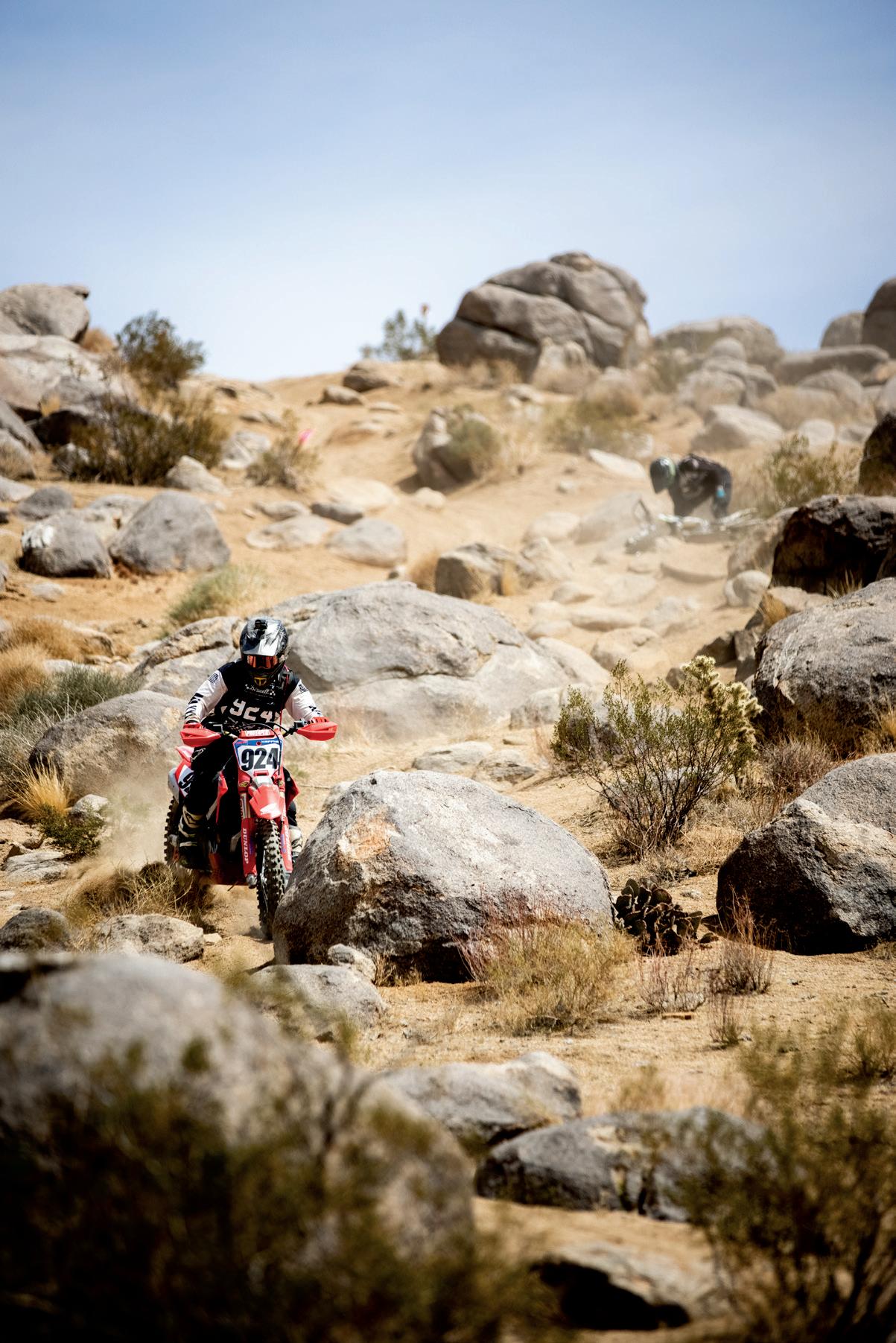

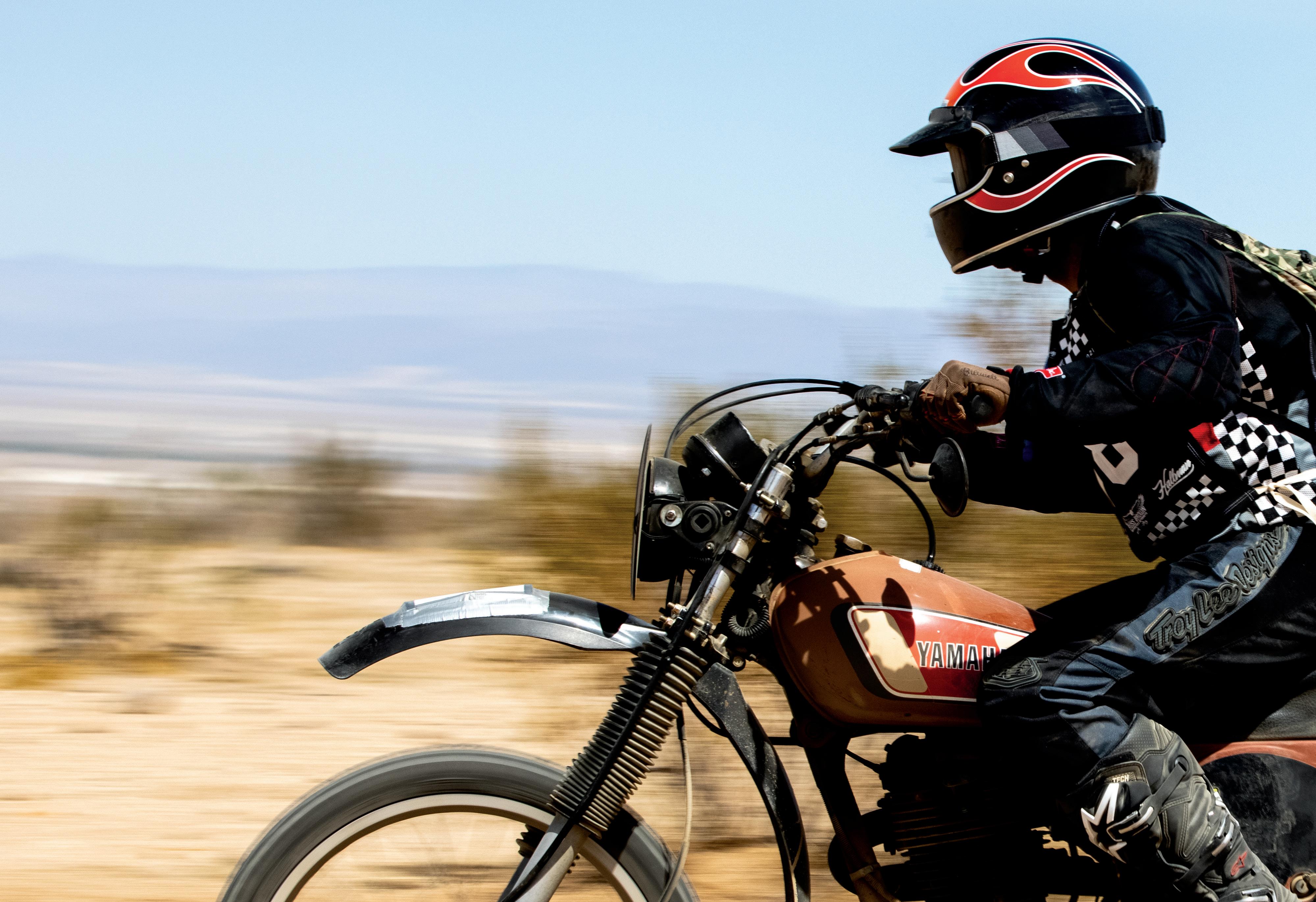


Free camping at most Biltwell events is a given (see El Diablo Run), and the 100 was no exception. With nearly 1,000 racers, friends, family and spectators on hand, the armada of trucks, toy haulers, tents and RVs that dotted the desert floor gave the event a festival feel. Generous sponsors stoked the good times further by filling goodie bags for every racer with loads of free stuff. At the rider’s meeting Saturday morning, Otto shared his mantra of “good times, not lap times” for the Biltwell 100, and that message resonated loud and clear. Not by accident, the Biltwell 100 was created for people who take their two-wheeled fun seriously.


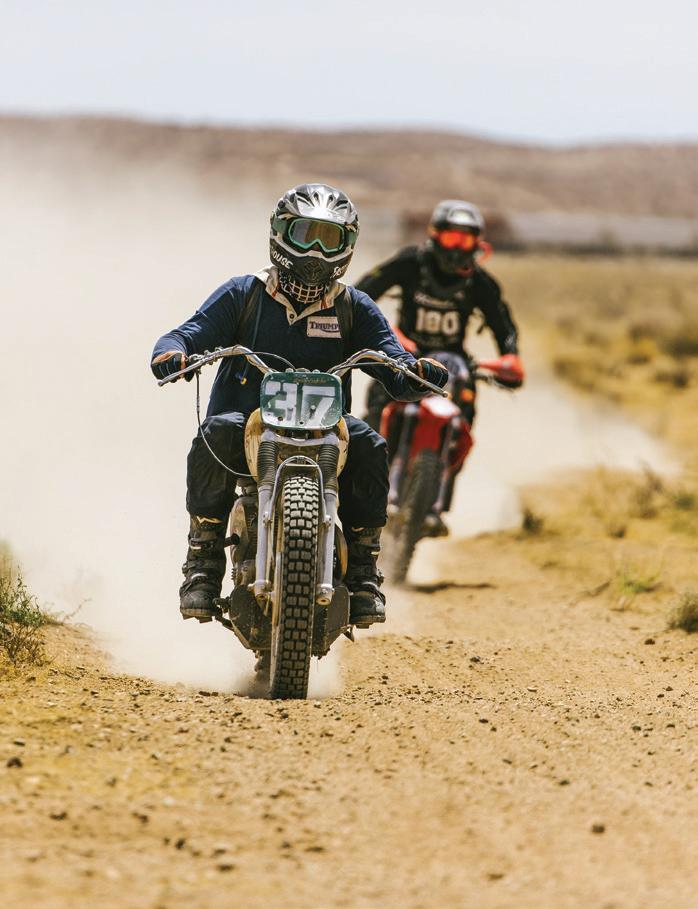



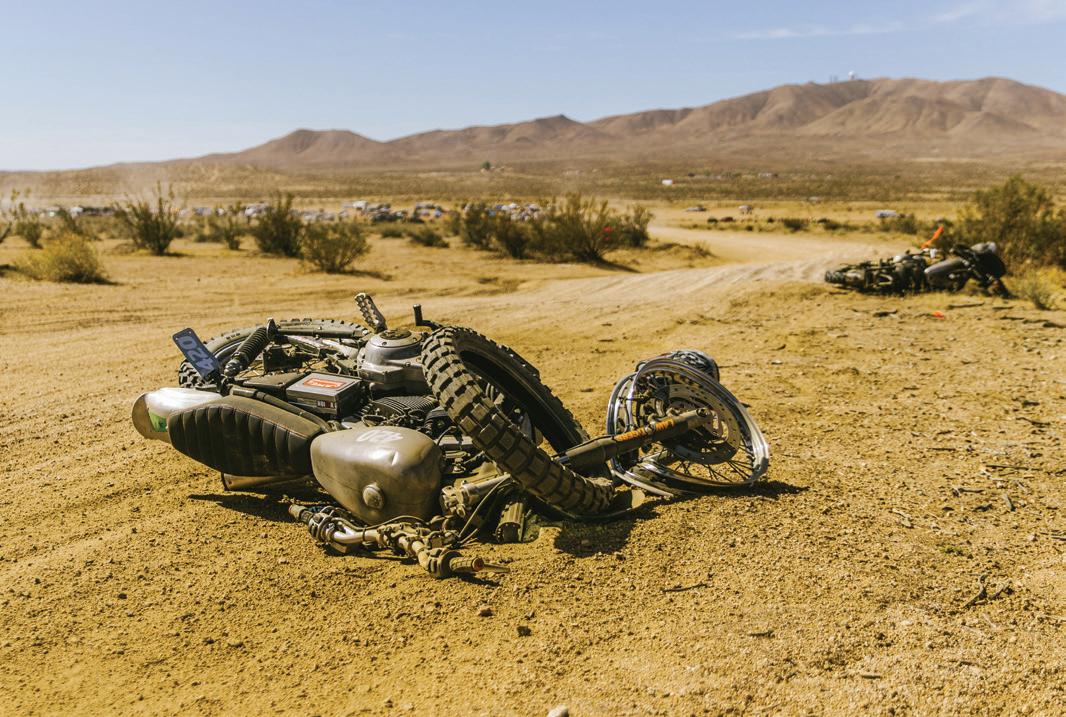

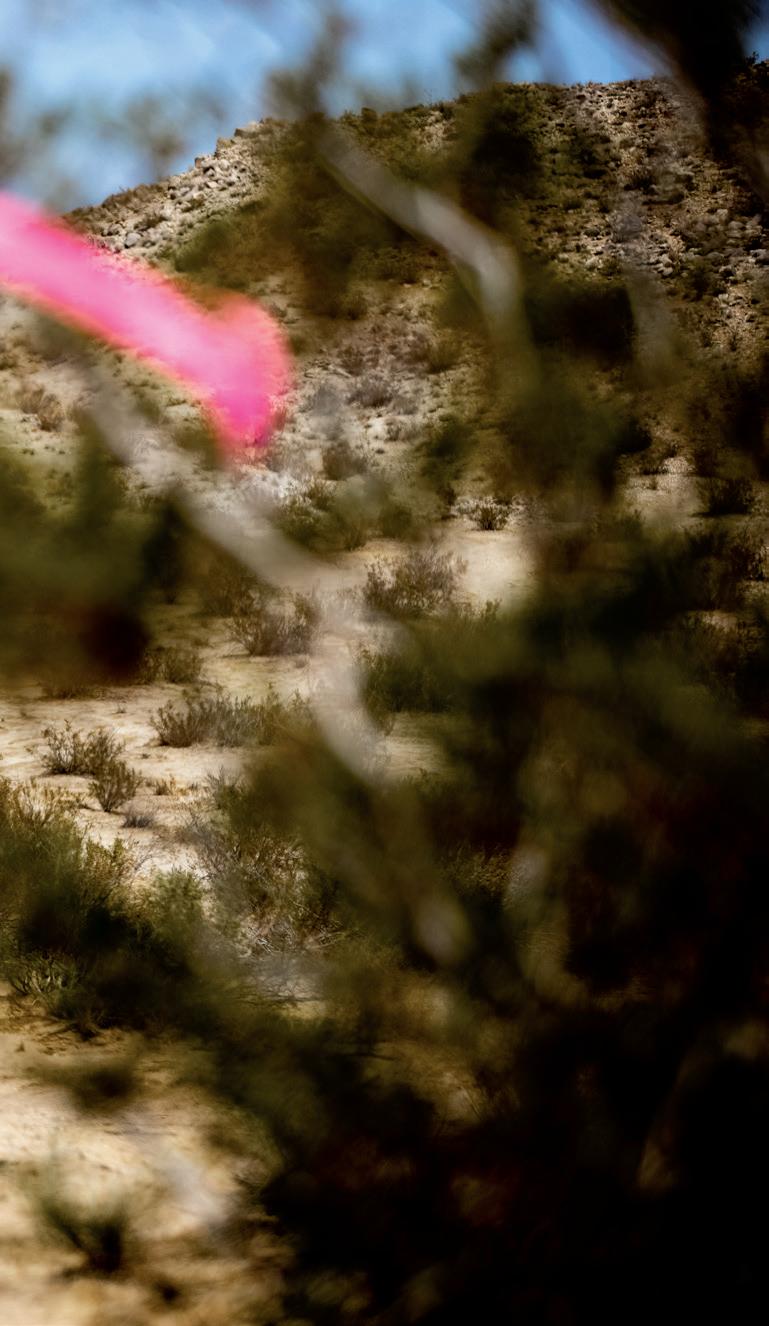





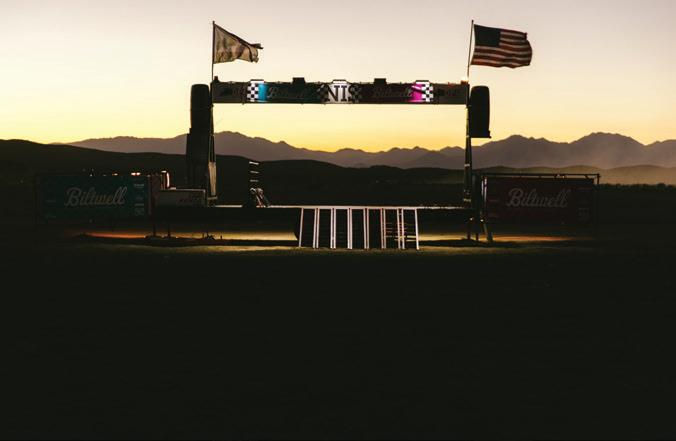

The importance of seeing clearly when you ride can’t be overstated. While the shield on your Biltwell helmet is a precise optical accessory, it’s not a bulletproof forcefield. After you hit the hundredth bug or the first hummingbird, it’s probably time to replace it. If you’re not sure, give it a quick inspection. Scratches aren’t a sign of failure—they’re proof the shield did its job. Each one means some airborne object didn’t poke your eye out in the fast lane—a BIG win. Celebrate your good fortune and smart gear choices by installing a new shield on your helmet.

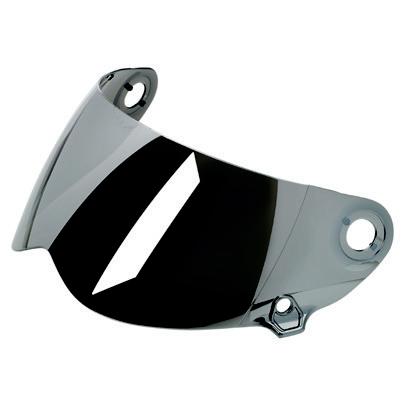




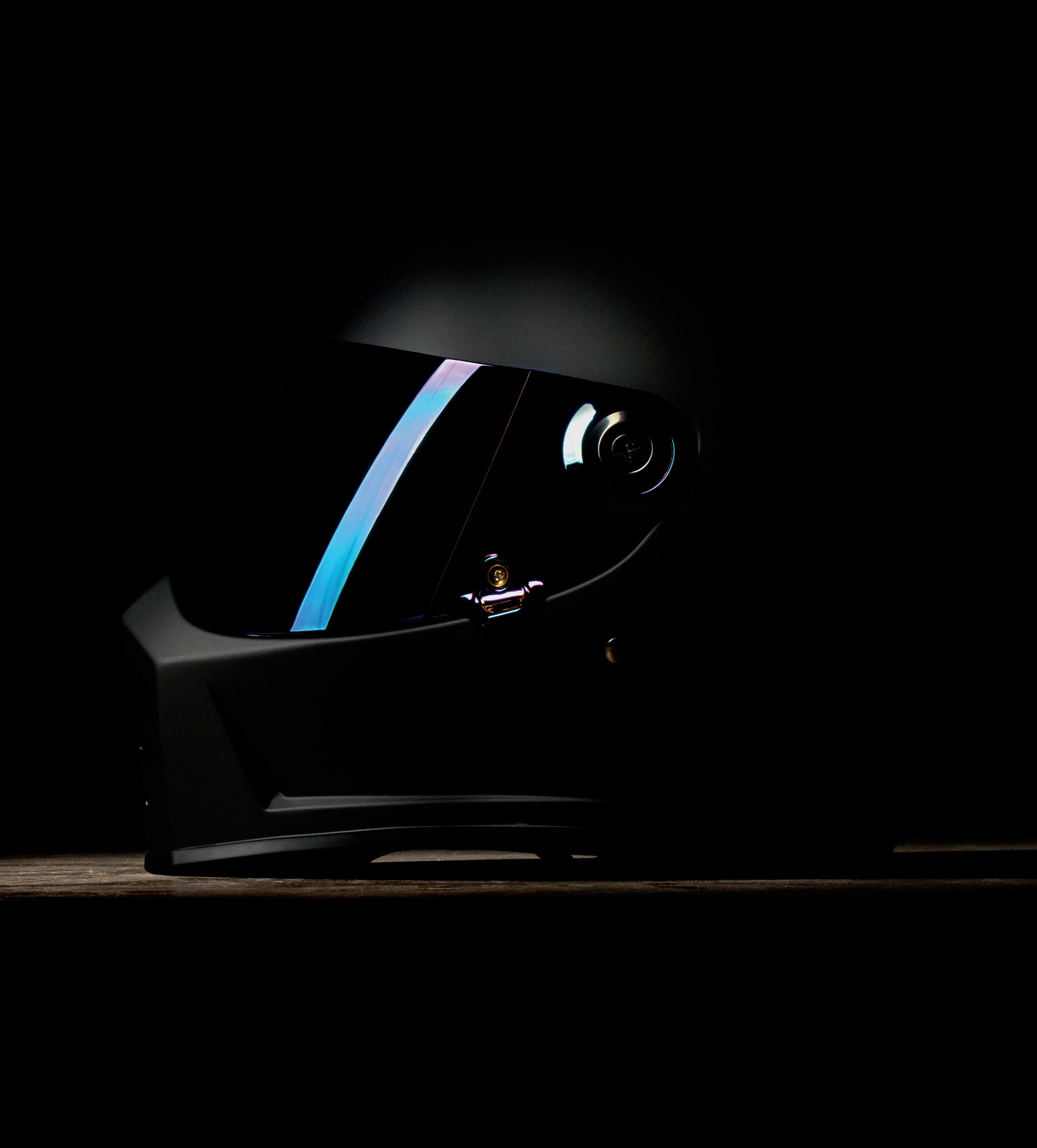

Every Lane Splitter and Gringo S shield is injection molded with impact- and scratch-resistant polycarbonate plastic. Yellow and smoke shields feature permanent in-mold colorizing. Mirror shields feature an electrostatic treatment that bonds the tint to the molded plastic. Every shield regardless of tint or treatment filters +91% UV/A and +99% UV/B ultraviolet light. Everyone deserves their day in the sun, but not at the expense of visual clarity.

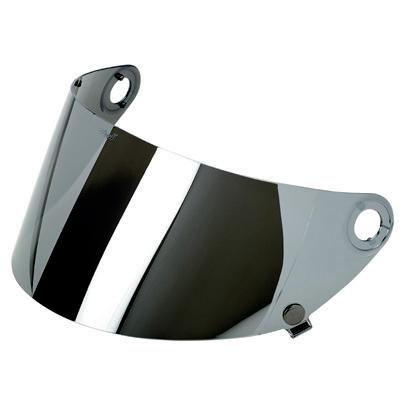


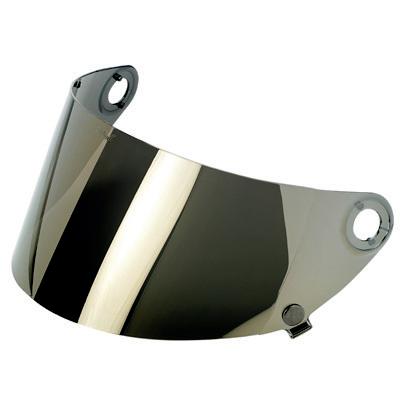



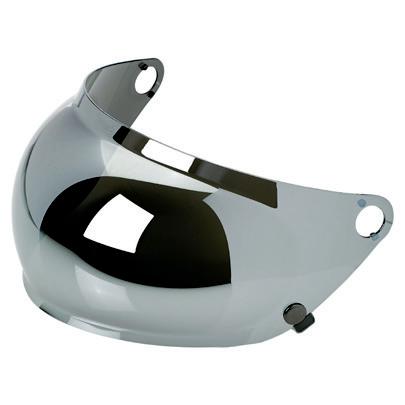

THE ROUTE:
Distance: 110 miles round trip
Elapsed time: 3 hours if you’re following speed limits; less if you’re adventurous, more if you’re curious
Terrain: Suburbs; windy desert two-lanes; verdant valleys; mountain forest; sod and citrus farms.
LUNCH:
Restaurant Gastrognome
54381 Ridgeview Drive Idyllwild, CA 92549 (951) 659-5055 www.gastrognome.com
TREATS: Dairy Queen 56265 Cahuilla Road Anza, CA 92539 (951) 292-7604 www.tinyurl.com/DQAnza
ATTRACTION: Ricardo Breceda Gallery 44450 Highway 79 South Aguanga, CA 92536 (951) 236-5896 www.ricardobreceda.com



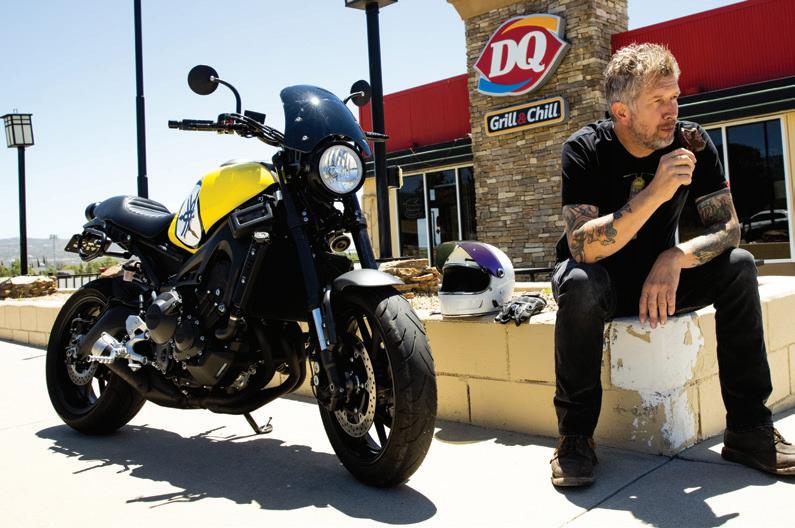

Words by McGoo / Photos by Geoff Kowalchuk
Day Trippin’ is a new feature in Parts and Labor where we share epic two-wheeled riding spots across America. To kick things off, here’s a route I fell in love with after I bought a fixer-upper in Idyllwild, a small village in the heart of SoCal’s San Bernardino National Forest. Nestled 5,700 feet above sea level among tall pines and massive boulder outcroppings, this wooded hamlet is a short but entertaining 55-mile ride from Biltwell headquarters in Temecula.
Winchester Road where the ride begins turns into State Road 79 as you head northeast, passing through French Valley before intersecting with Domenigoni Parkway in Winchester. Domenigoni is a flat, high-speed fourlane that dissects acres of dusty sod farms on its way to Hemet. Circumnavigating this bedroom community on side streets is advised, and the route provided on the QR code meanders through old neighborhoods and beautiful orange groves before feeding onto Highway 74 in the foothills east of town. This is where the fun begins.
The ribbon of swoopy two-lane from east Hemet to Mountain Center climbs 2,900 feet in 15 miles before reaching the gas station at Highway 243. Fill up here so you don’t suffer long lines at the Shell station in Idyllwild. After topping off, head north on 243 five miles to Idyllwild. Merge right at Ridgeview Drive in downtown Idyllwild and follow it to town circle. Your destination is Restaurant Gastrognome, one of Idyllwild’s oldest and most eclectic eateries. The ‘Gnome has set the standard for fine dining in Idyllwild since ’73. It looks like it, too, with 75-foot-tall trees jutting through the outdoor dining deck overlooking downtown. If you’re hungry—and you should be—I recommend the French onion soup, followed by the lump

crab cake appetizer as your entree. Ask your waitress to keep the complimentary bread and olive oil coming, but don’t get dessert—you’ll stop for gas on Highway 371 in Anza, and there’s a Dairy Queen next door.
Leave Idyllwild the same way you came. When you reach the gas station where you topped off in Mountain Center, take the fork in the road heading left. This is Highway 74—a fast, rolling stretch of two-lane that takes you past Lake Hemet and Thomas Mountain turnoff on its way to the Highway 371 intersection at Paradise Valley Café. Turn right at the café to descend into Anza Valley, home of the Cahuilla Indian Reservation and Lake Riverside Estates, a dusty housing development with its own fishing pond and gravel airstrip. After seeing where citizens of Anza Valley live their best lives, count your blessings over a Dilly Bar at Dairy Queen, then keep riding south.
Highway 371 terminates at State road 79. You’ll turn right and head back to Temecula here, but not before stopping at renowned sculptor Ricardo Breceda’s outdoor gallery. Señor Breceda’s medium is metal, and his art is extralarge—everything from stallions and stagecoaches to his best-known piece, a 350-foot-long serpent that basks in the sand in nearby Borrego Springs. Get a tetanus shot before touching anything, however; Ricardo’s stuff is rusty, and much of it has teeth. After you leave Ricardo’s gallery, Biltwell is 15 miles of mostly suburban stop-andgo past tract homes and strip malls. The juxtaposition of urban sprawl, arid desert, rolling farmland, and majestic forest on this 110-mile loop is a striking reminder of Southern California’s geographical diversity, and a big reason we call this place home.

Whether it’s riding BMX, racing mountain bikes, or twisting the wick on his race-prepped Dyna, @ravi_savage does his thing, his way
Name, age, hometown.
Where did you learn to ride like a savage?
Pepperoni or Canadian bacon?
Who were the guys you looked up to when you were younger?
Who do you look up to nowadays?
Dobermans! Why not pit bulls?
Besides riding, what are your other interests?
Best cop story?
Ravi Patel, 23 years old from Riverside, California.
I grew up racing downhill mountain bikes, so two wheels isn’t foreign to me. It took lots of practice and crashing to get where I am today, but I’m still nowhere near where I want to be. This sport is constantly growing, and there is so much more to learn.
Pepperoni, aye!
Guys like Twitch, the Unknown Industry guys, and @tallboytee all inspired me to do what I like to do. These guys are shredders and everyone made their passion their career!
Eric Stahl from @jiffytune—he paved his own path and made his way into MotoAmerica racing a Harley as a privateer. Seeing a guy do something on his own is so rad, and something that inspires me to go out and do more.
I didn’t choose the dobe life, the dobe life chose me. Plus, have you seen the size of Blue’s chest?
My life outside riding is rad! I love to be outdoors all the time. Whether it’s hiking, going to the dog beach, or riding my BMX bike, I love to be active and outside. On my off time, I’m usually crafting little art projects or working on new bike builds.
Ooof—there are a bunch! My favorite one has to be when I got pulled over at Quaid Harley-Davidson’s Ride the Runway back in 2019. I was brought out to the event to lead the group of Harleys that were entering the air show—the promoters wanted me to do some wheelies. So I’m doing a wheelie mid-runway and I see lights in my mirror coming up hot. When I set it down this motorcycle officer pulls next to me screaming “Pull the fuck over!” on his PA. I pulled to the side of the airstrip in the middle of the show while the cop kept chewing me out—he wanted to throw me out of the event! After talking with event coordinators the officer let me go, but he was not happy about it and definitely made it clear he didn’t like me. Funny thing was, everyone on Instagram thought it was staged!
Any regrets?
I try to live my life with no regrets, as I am a firm believer that everything happens for a reason. There’s no such thing as a mistake, only a redirection.
Continued on page 38

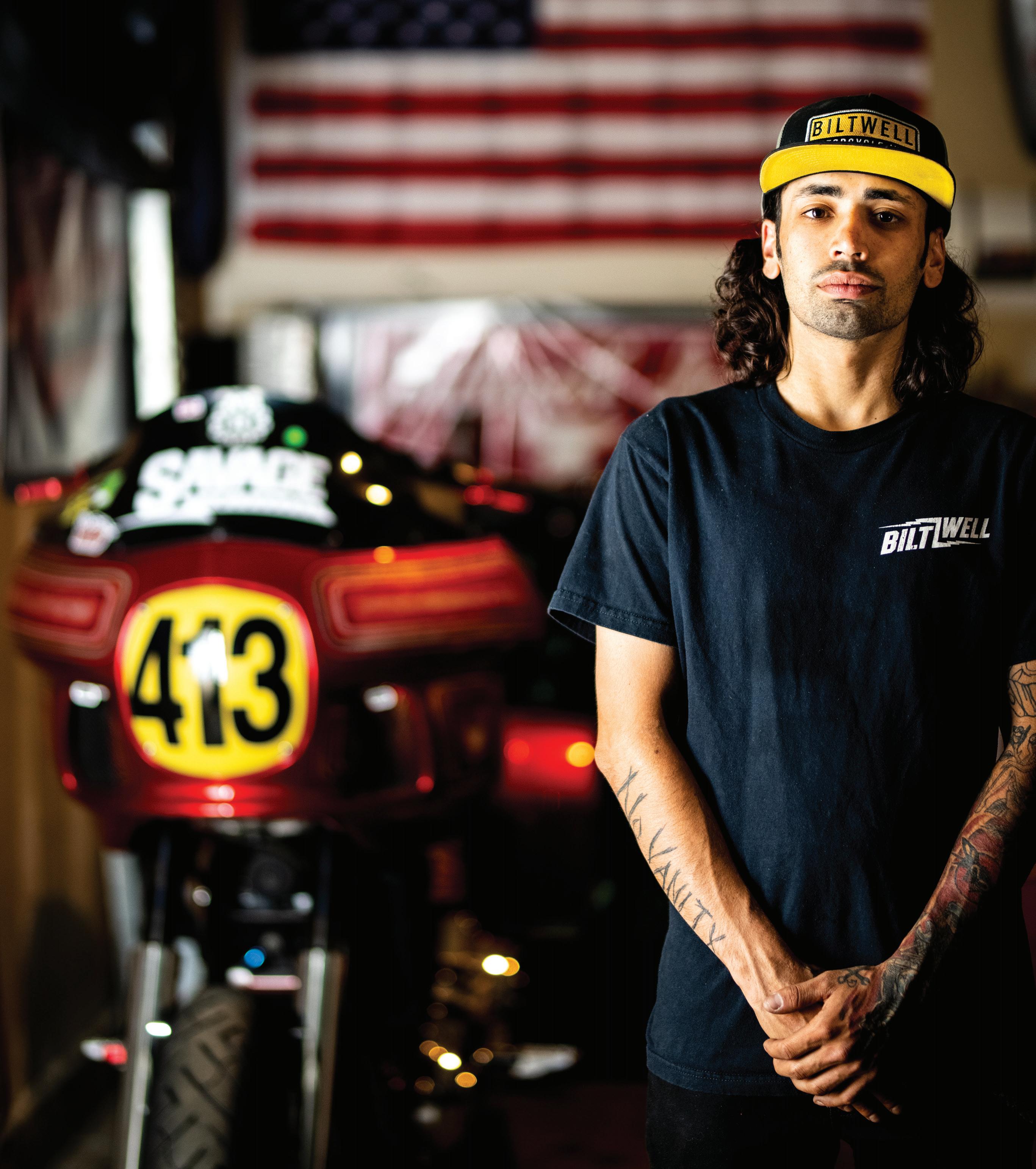
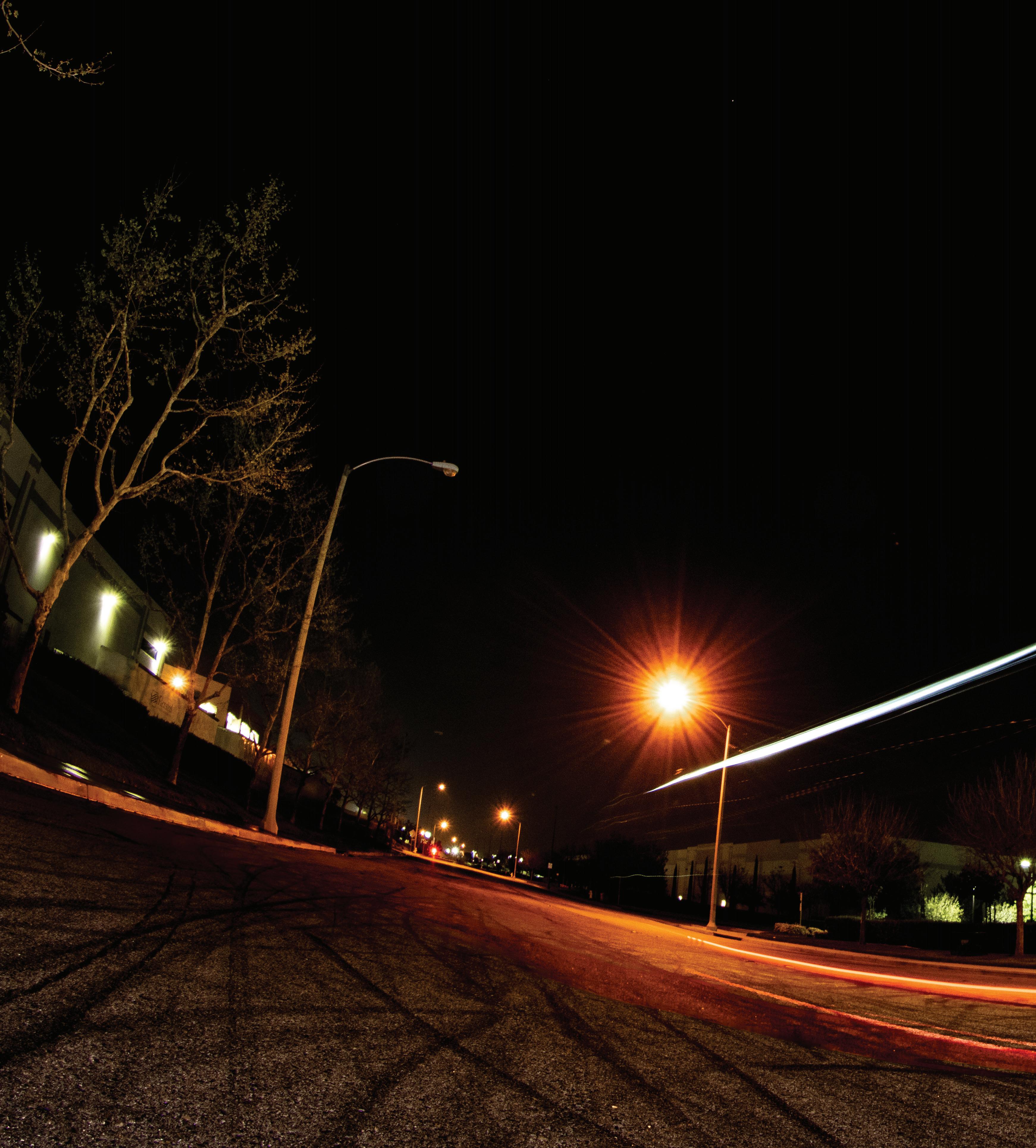

Any advice for young up-and-comers?
Shoutouts?
My best advice for young riders is to stay humble and be a nice person. No matter how good a rider you are, if you aren’t nice, no one will want to support you or be your friend. Like my old pal Otto told me, “Nice guys finish first. It might take a while, but they always finish.” That motto has stuck with me ever since I heard it, and I’ve been living by it ever since.
There are so many people and companies that have helped me in my riding career and in my personal life. From learning how to ride and work on bikes, to being a good person in today’s society—so many people have contributed knowledge and experience to help create who I am today. Shoutout to everyone around me, and thanks to every single one of you!
What’s the story on your new project @ savagepowerhouse?
Your girl Mel’s pretty hot—think you’ll be able to keep her?
Savage Powerhouse is a partnership between me and The Chopper Place in Riverside, CA. We started it to bridge the gap between new- and old-school. With 50-plus years of knowledge from the guys at The Chopper Place and my younger style, it was time to merge the generations and work together. Savage Powerhouse is an e-commerce site that offers parts, tools, gear, and accessories for all powersports. These days people seem so misinformed about so many things. Our goal is to offer trustworthy and reliable sales and service to people in the powersports industry, and those who are just learning. We are also a Harley-Davidson road race team that’s working toward getting into MotoAmerica.
Ha! I’m trying, man. She’s definitely way out of my league, but I’m trying to give us normal guys hope!


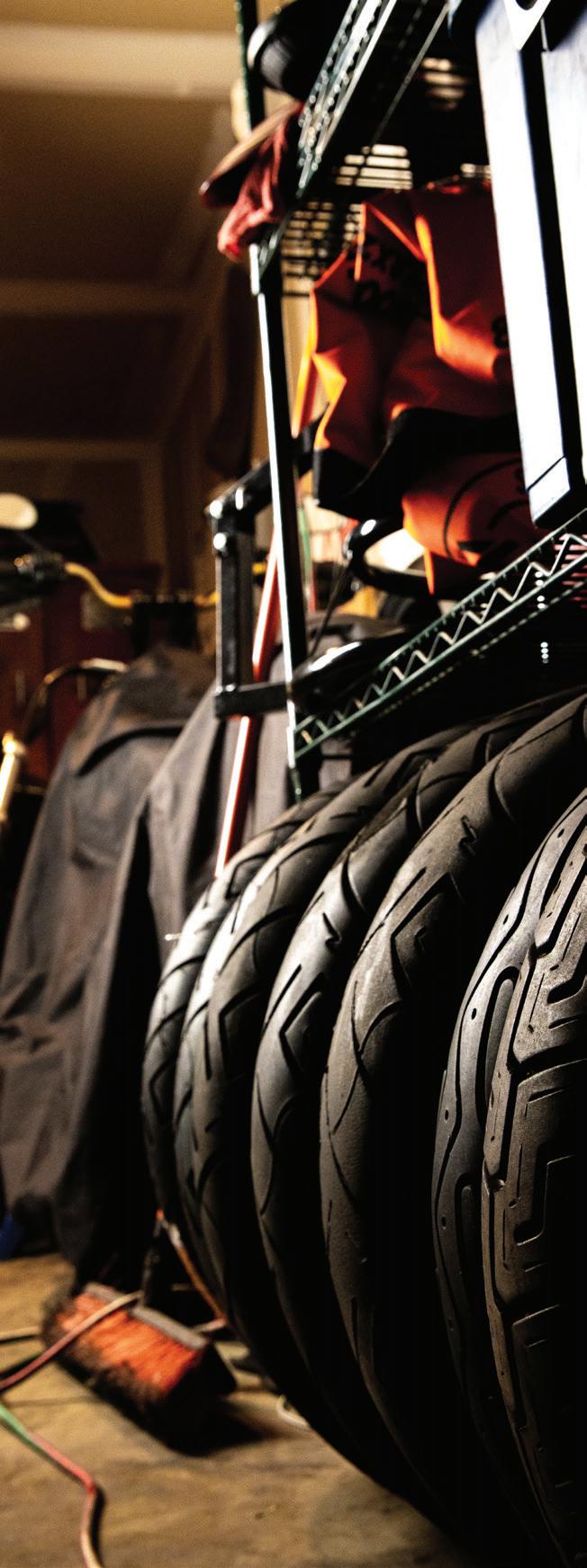



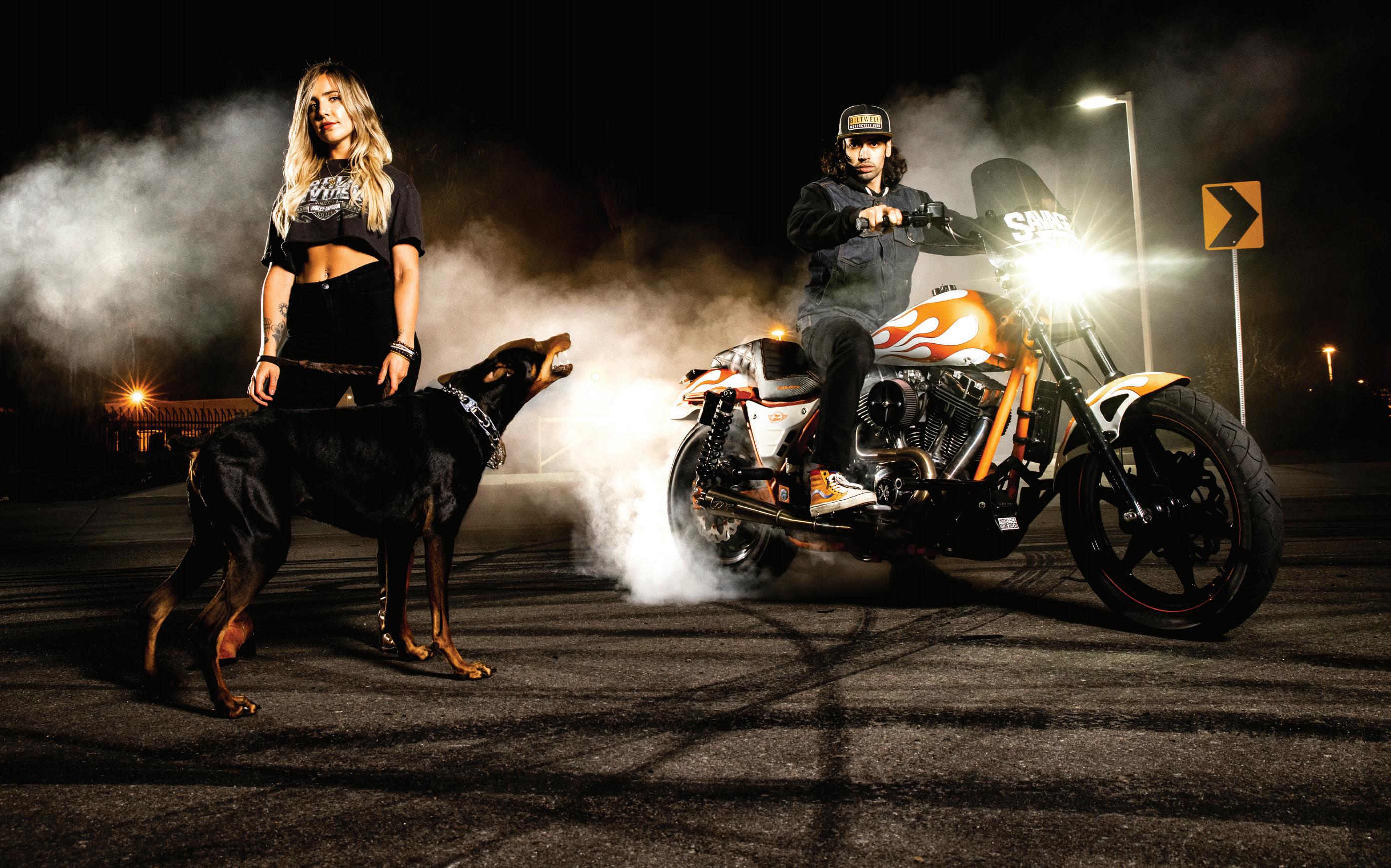
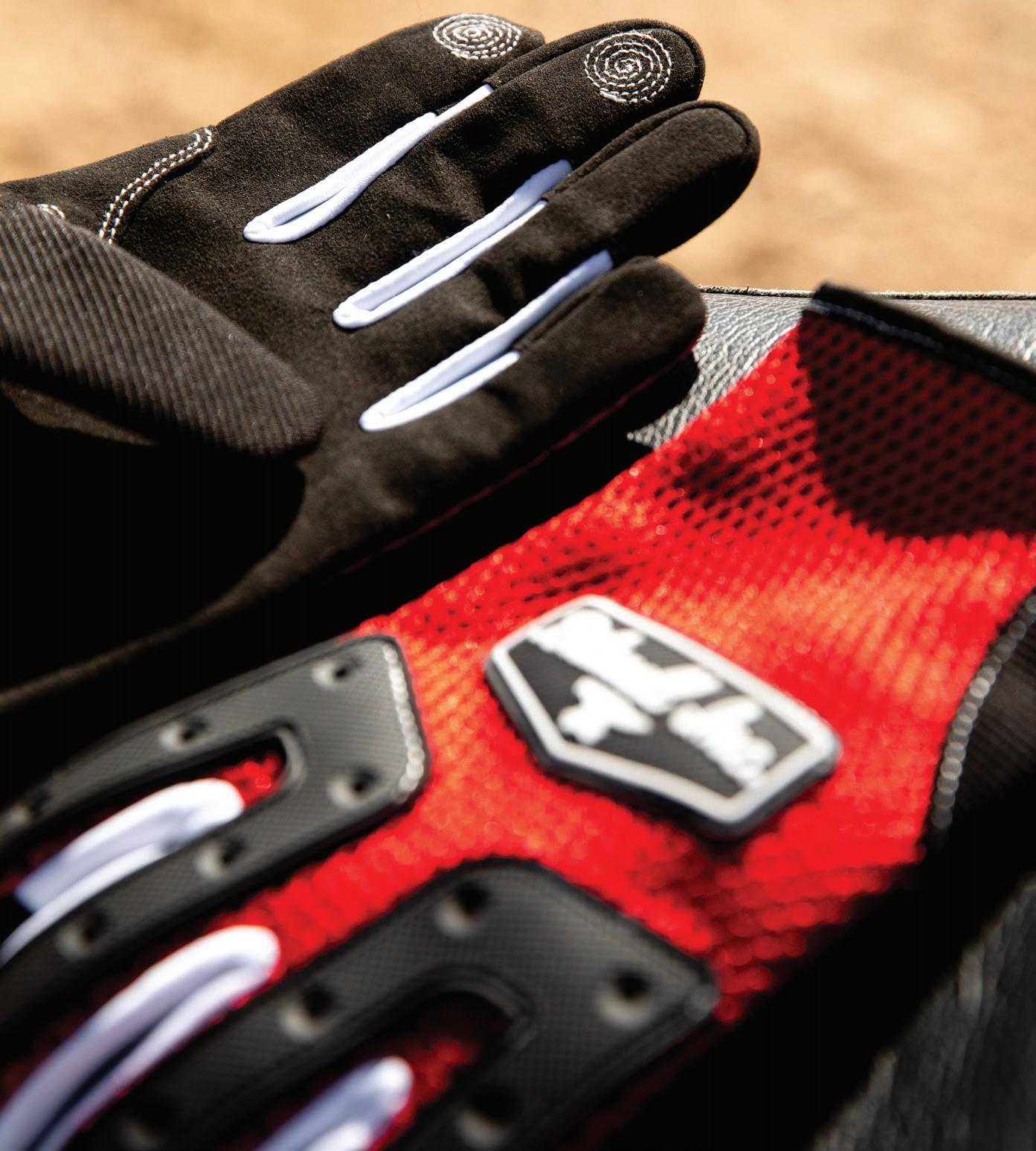


WE MINED THE GAMUT OF TWO-WHEELED ENDEAVORS TO BUILD THE DNA FOR OUR NEWEST RANGE OF HIGH-PERFORMANCE GLOVES
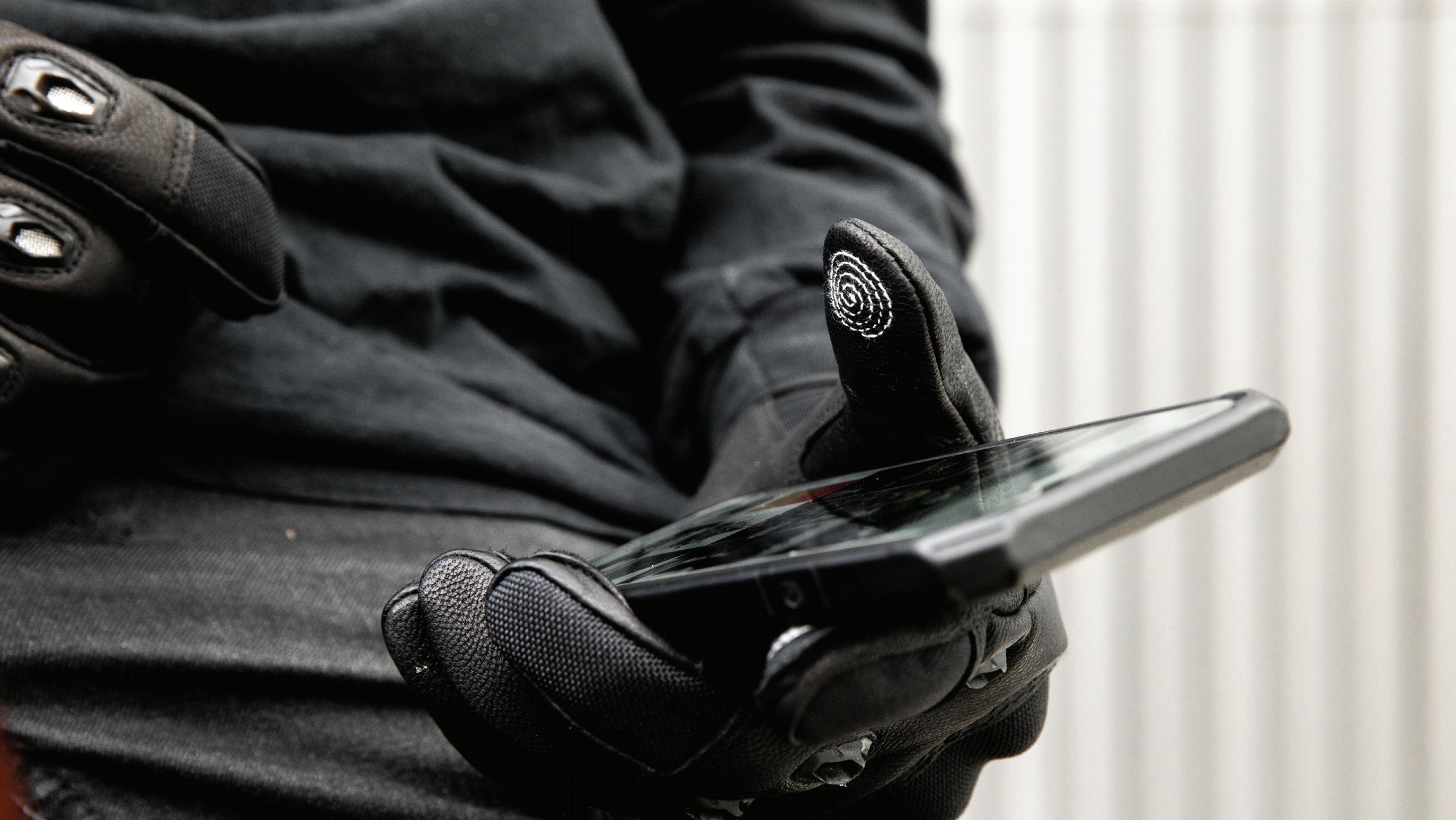

Now more than ever, progressive builders and bikeriders are blurring the lines of what’s possible on a motorcycle. Not long ago, modifying a Sportster to go desert racing was unthinkable, something akin to dragging your knee on a bagger at Laguna Seca. Today, Dyna bros wheelie high-performance hogs like stolen beach cruisers. These shifts aren’t moments—they’re movements. Riders at the sharp end of the revolution have deep roots and eclectic tastes—everything from motocross and skateboarding to sport bikes and BMX. From these influences we mined the functional and aesthetic DNA to create three new gloves for two-wheeled adventure.
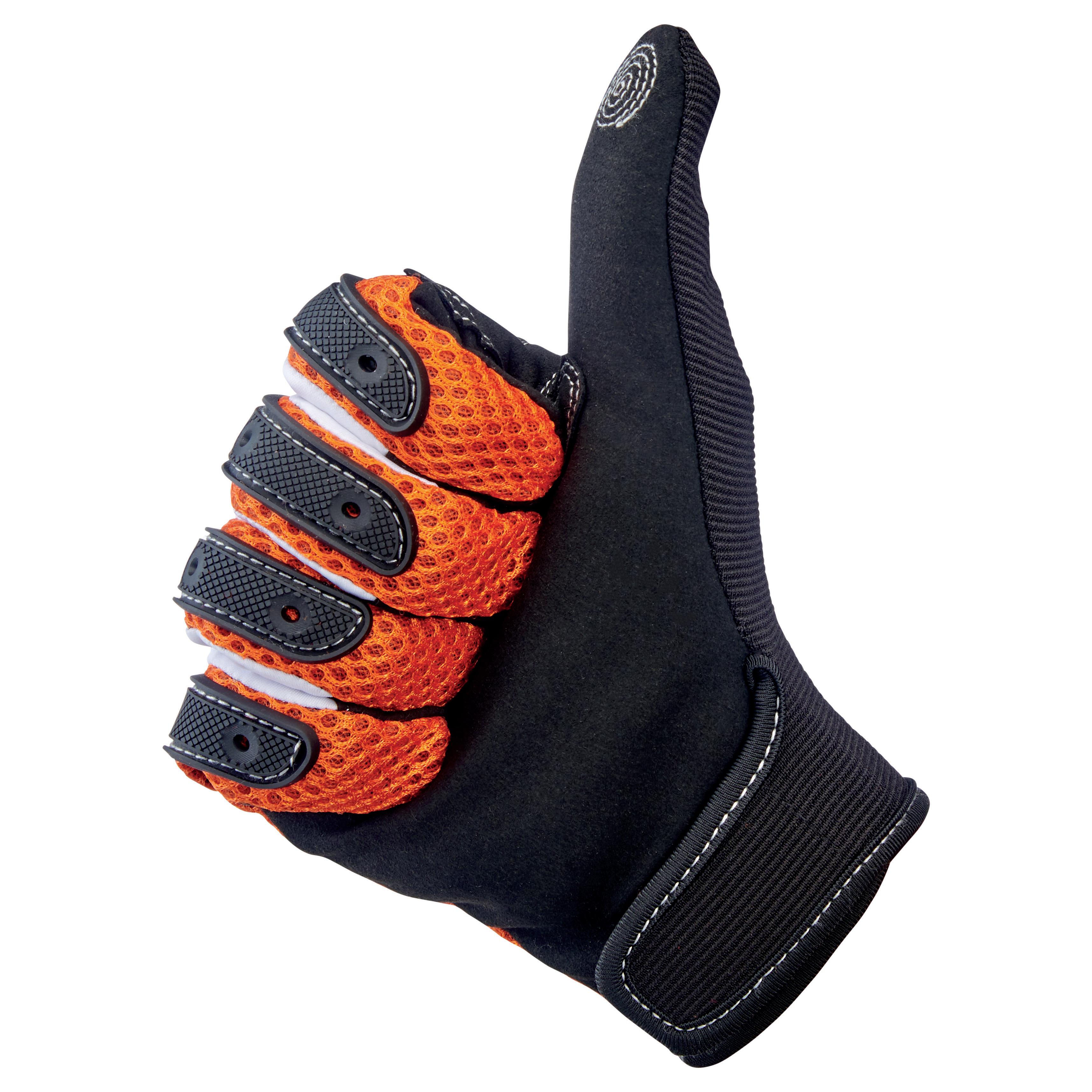
Multi-directional stretch materials and anatomical construction give Anza a snug, comfortable fit for blister-free riding
Dinosaurs died 65 million years ago so our best full-synthetic glove could live


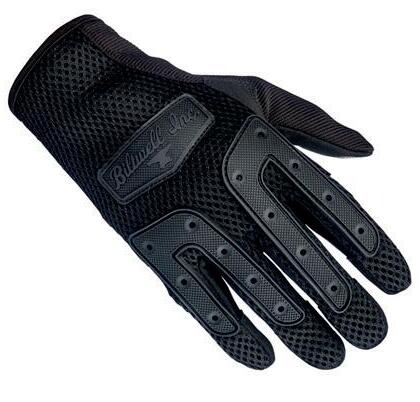

Designed and hand-crafted to provide a snug, comfortable fit, Anza is the most advanced full-synthetic glove in our line. Woven mesh back panels provide maximize airflow to evacuate sweat and improve cooling. Stretch synthetic suede palm panels conforms to the shape of your hand to eliminate bunching. Thermoplastic rubber knuckle guards deflect heavy roost and flying road debris. Lycra baffles in the finger joints stretch to reduce cramping.
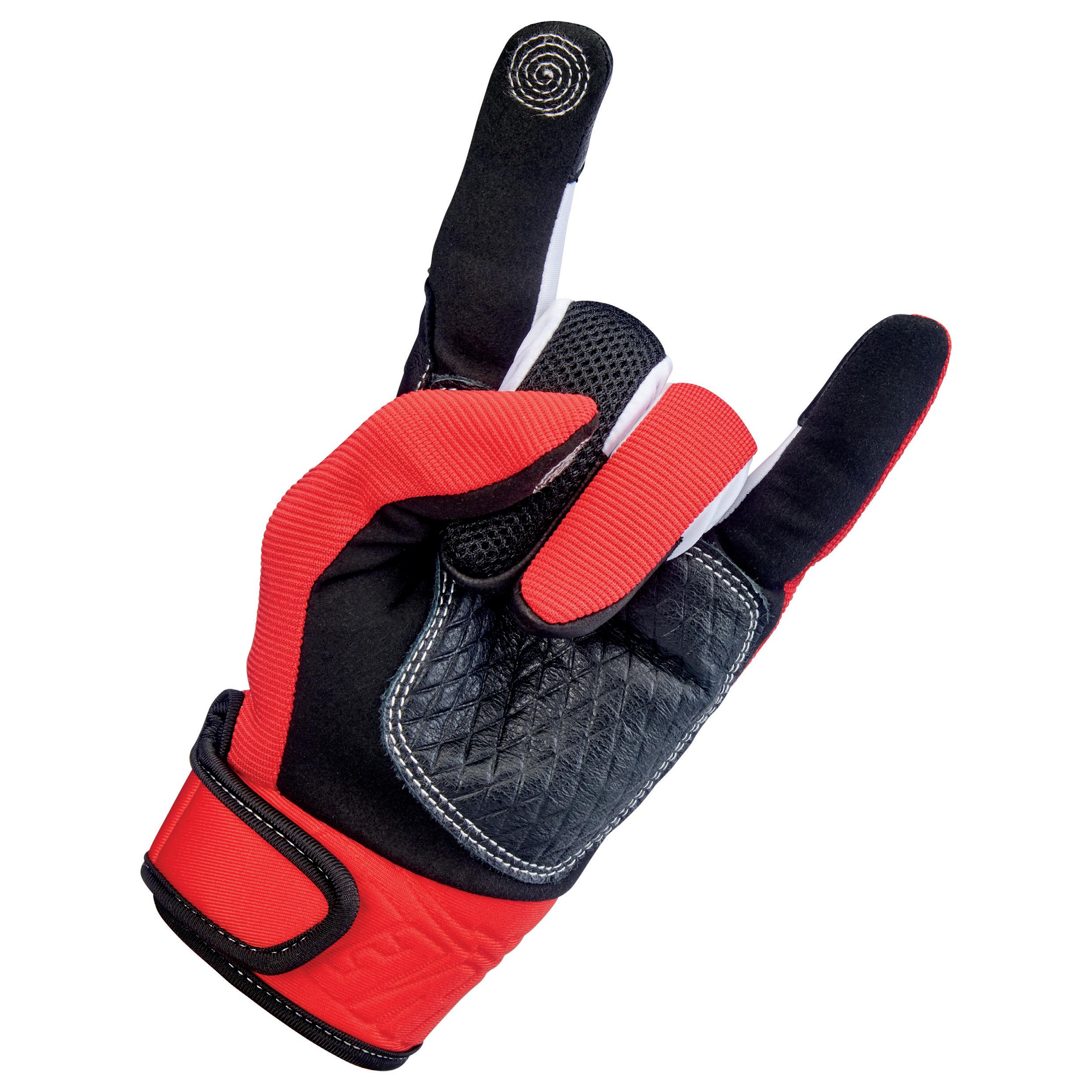





The ‘80s were the Golden Age of American motocross, when gear design and material technology moved nearly as fast as the champions who wore the stuff. Those legends and that era were the inspiration for our Baja glove. Aggressively styled. Beautifully hand-crafted. Fortified with embossed goatskin leather for protection that’s CE certified. You can’t ask more from a motorcycle glove than that.
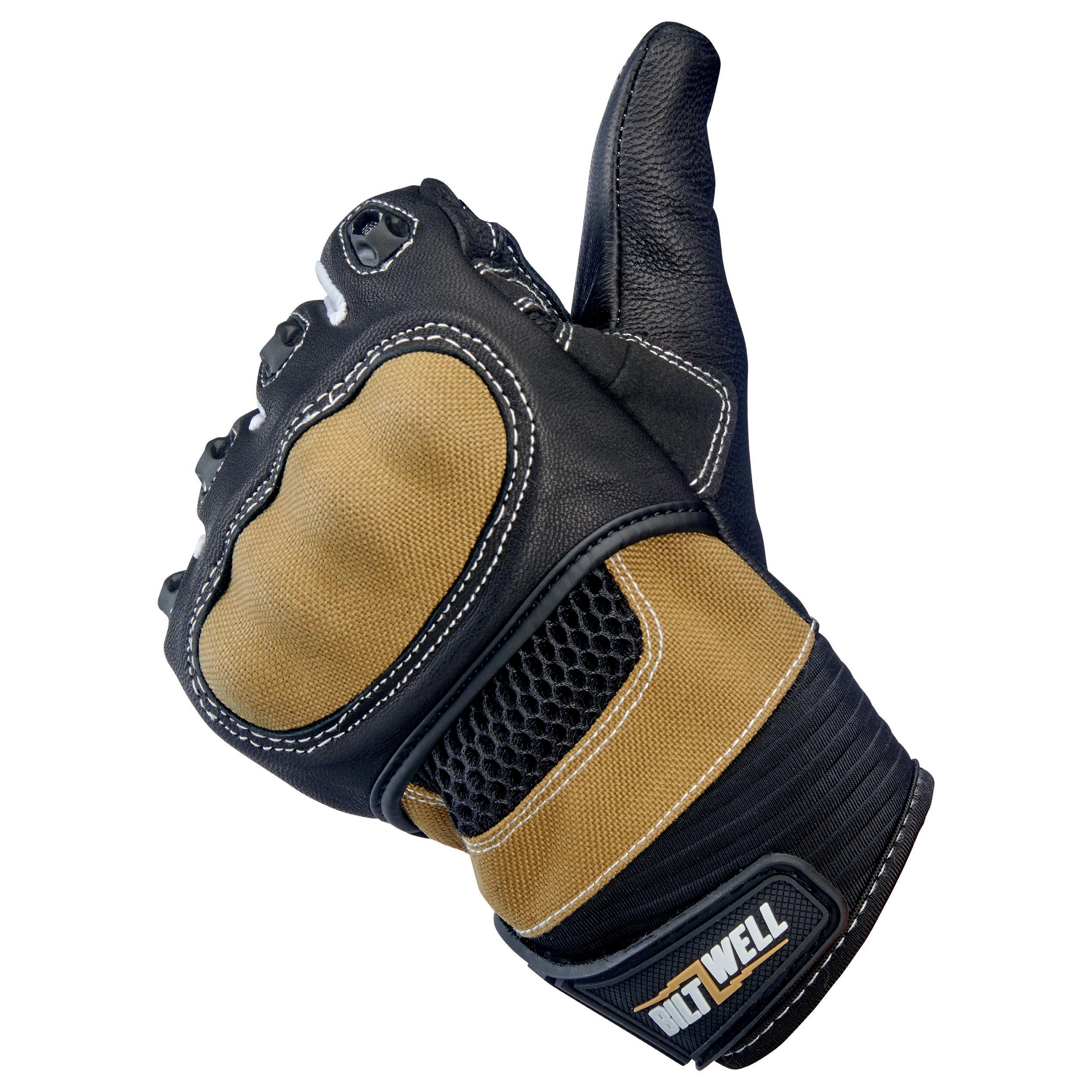
Multi-stretch textiles and supple goatskin leather construction gives Bridgeport exceptional comfort and dexterity, especially on long rides
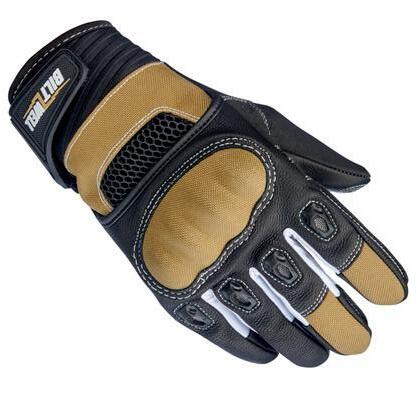

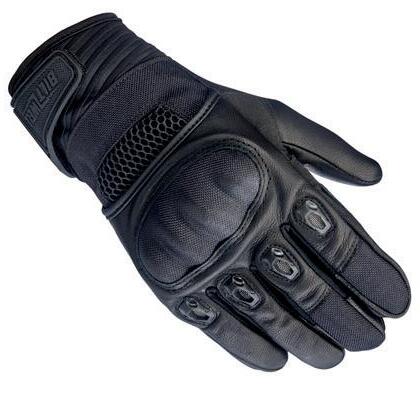


Like every leather/synthetic hybrid on the grid, Bridgeport features rugged construction and a racy silhouette. The stuff you can’t see is what puts our most advanced glove on top of the box. Bridgeport’s molded plastic knuckle guards feature neoprene padding to dissipate impacts. Fleece Lycra touch points inside keep sweaty palms dry by wicking moisture away from your skin. Outside, supple goatskin leather, vented polyester, and ballistic nylon combine forces to build a glove that’s damn near bulletproof.

One Man’s Journey Through the Retro/Modern Motorcycle Universe
This story is not unique. Millions of middle-aged men before me have swilled Harley’s bright orange punch without getting hammered on the hardware or heritage of America’s preeminent motorcycle maker. I blame my Big Twin malaise on my childhood. As the sole progeny of a workaholic single mom in the ‘70s, I owned three motorcycles before my thirteenth birthday: a Montesa Cota 25 trials bike, a Chaparral 80 trail bike, and a Hodaka Dirt Squirt 100. The two-wheeled affliction of my adolescence turned me into a motorcycle nerd for life, with an affinity for Japanese machinery.
In motocross, it was the exploits of five-time world champ Roger DeCoster aboard his Suzuki RN400 that put nitrogen in my short-travel front end. Kenny Roberts—America’s first Moto GP winner and 3X FIM World Champ—was my hero in American dirt track and European road racing. Roberts’ legendary assault from the back of the grid on polesitter Jay Springsteen’s dominant Harley XR750 at the Indy Mile in ‘75 seared King Kenny and his works Yamaha TZ750 two-stroke into my brain. It took me five decades to do it, but I knew someday I’d own a Yamaha in screaming yellow, black and white livery. But first, I had to dip my toe into the kiddie pool.
After building and flipping four Harley choppers between 2005 and 2011, I finally owned my truth and bought a Japanese street bike, Honda’s revolutionary new NC700x. While hardly the stuff childhood dreams are made of, Big Red’s New Concept commuter bike had a 68 MPG range and nearly four gallons under the seat, so fuel anxiety wasn’t an issue. A good thing, because Biltwell co-workers and I were planning a circumnavigation of Baja after the El Diablo Run in spring
2013. Having been derived from components in Honda’s automotive parts bin, the NC700x was reliable, but also low-revving and slow. Bringing up the rear as I did for every mile of that two-week journey, I had plenty of time to reflect on those shortcomings, and my own. As I learned the hard way after eight nights in a pup tent, sleeping on the ground was no longer my jam. Neither were roadside tune and service drills. After enjoying 3,000 miles of the most trouble-free riding of my life, I sold my NC700x and set about finding the ultimate motorcycle for my eclectic—others might say effeminate—tastes.
According to BMW Motorrad’s website, the RnineT presents “bold opportunities for customization, and no limit to one’s self-realization.”
...ONE MONTH INTO LOCKDOWN I BURNED MY HOUSE TO THE GROUND WITH A DIRTY WASHCLOTH AND A HALF-PINT OF BOILED LINSEED OIL.
Sold. I bought the cheapest model in BMW’s arsenal, strapped an EXFIL-115 to the rear fender, then blitzed backroads from SoCal to Seattle with friend and fellow ad flack Pete Kearney in September 2019.
The successful rebirth of Triumph’s Bonneville marque in 2001 set an early tone for where motorcycle styling might be headed in the new millennium. I owned a mildly customized Hinkley Triumph in the mid-aughts, but determined its ROM (Regular Old Motorcycle) engine and architecture were better suited for bar hopping than cross-country hauling. In 2014 Ducati introduced their reimagined Scrambler. That machine’s modern engineering and playful desert sled aesthetic made the diminutive Duc a global success. Never one to be outdone by Italian competitors, BMW delivered their RnineT to US shores in 2015. As is so often the case with shiny things, I stared at that Bavarian boxer for three-and-a-half years before screwing up the shekels to buy one.
After 1,600 miles of effortless coastal cruising and canyon carving, however, Germany’s interpretation of the retro/modern motorcycle left me cold—too stoic in its Teutonic demeanor for my brasher tastes. I sold Frau Mërkel to a trust fund girl on Halloween, then bought a 2020 Moto Guzzi V85TT after Christmas. It wasn’t the Yamaha of my dreams, but copious internet research had convinced me Italy’s latest take on the retro renaissance was exactly what I needed to see the world.
Before I could log even 350 break-in miles, however, my feces literally hit a Cat 5 hurricane-strength wind machine.
Last year’s Covid-19 safety protocols gave bikeriders a great opportunity to enjoy socially distant me-time behind bars. I was prepared to draft that bandwagon, but one month into lockdown I burned my house to the ground with a dirty washcloth and a half-pint of boiled linseed oil. My brand-new Moto Guzzi went up in flames, along with all my other hopes and dreams. After receiving insurance money for that monumental fuckup, I scoured CycleTrader.com for a
new motorcycle. An old-stock 2019 Yamaha XSR900 in bland burgundy and gunmetal livery caught my eye. I’ve never been a fan of sport bikes. My fat ass won’t fit in the saddle, and my middle-aged spine doesn’t bend far enough to reach the clip-ons. While it shares an engine, chassis technology, and technical DNA with their vaunted FZ-09 (now MT-09) naked streetfighter, my more relaxed and refined XSR900 falls into what Yamaha calls their “Sport Heritage” category. I don’t know where that pigeonholes the XSR900 in popular parlance, but moto journalists seem to have an idea. After enjoying the XSR900’s upright ergonomics and 10k redline at its American press debut in 2016, magazine test riders and YouTube influencers alike hailed Yamaha’s naked/UJM hybrid the best “Neo-Retro” motorcycle from Japan. They might be correct. I’ve owned or ridden many of the best machines in today’s burgeoning retro/modern niche. Few challenge the XSR’s speed and quickness (113.5 hp/65 ft. lb. of torque), nimble handling (fully tunable suspension, 430 pounds wet), stopping power (triple discs), or the sonic satisfaction of its 847cc inline triple engine. In a word, I found Yamaha’s XSR900 sublime—all it needed was some mods and paint to make it mine.
When my victims are bicycles or choppers, wrenching comes easy. Things get weird when I buy motorcycles with ABS, EFI, YCC-T, VVT, D-MODE, eco LCD instrumentation, or kill switches on the kickstand. Gobsmacked by its glut of digital gimmicks, I decided simple ergonomic and aesthetic—not mechanical—tweaks were the best my Kenny Roberts replica would get.
To address its slightly stretched-out, bent-over ergonomics, I found a pair of riser gizmos on eBay that moved
my XSR’s four-bend alloy bars two inches up and nearly three inches back. Sayonara, sciatica. Although Yamaha claims they are mid-sets, the location of my XSR’s stock foot pegs put too much tweak in my knees. Time on FZ09.com yielded a solution from Germany that put my feet one inch forward and nearly two inches down—just enough extension to give my ACL some R & R. Of course, my ass is too big for anything Yamaha engineers charitably call a seat, so Duane Ballard reshaped new foam on my stock pan, then covered it with clean leather upholstery. After replacing the blinkers with micro LEDs and throwing on a 20-dollar fairing from Alibaba, my Kenny Roberts Replica was ready for racy new paint courtesy of “Hot Dog” Pete.
When it was time for Pete to wave his magic spray gun, I didn’t have the guts to put King Kenny’s iconic black-and-white stripes on my tartedup retro rocket—that paint should be reserved for men who can drag a knee. Knowing Yamaha’s history as a piano maker (another thing I can’t do), I went with the mothership’s tuning fork logo. Now when I post up for mochas and motos at Starbucks, everyone can guess who ordered the skinny chai latte and German chocolate lollicake: the fat old man on his wife’s bright yellow Yamaha. Whatever. My best-in-class retro/ modern Japanese screamer might not look like Roberts’ TZ750, but it damn sure performs like one. Being 44 years newer, I’ll say even better.

...MY ASS IS TOO BIG FOR ANYTHING YAMAHA ENGINEERS CHARITABLY CALL A SEAT, SO
BALLARD RESHAPED NEW FOAM ON MY STOCK PAN, THEN COVERED IT WITH CLEAN LEATHER


I FOUND A PAIR OF RISER GIZMOS ON EBAY THAT MOVED MY XSR’S FOUR-BEND ALLOY BARS TWO INCHES UP AND NEARLY THREE INCHES BACK. SAYONARA, SCIATICA.

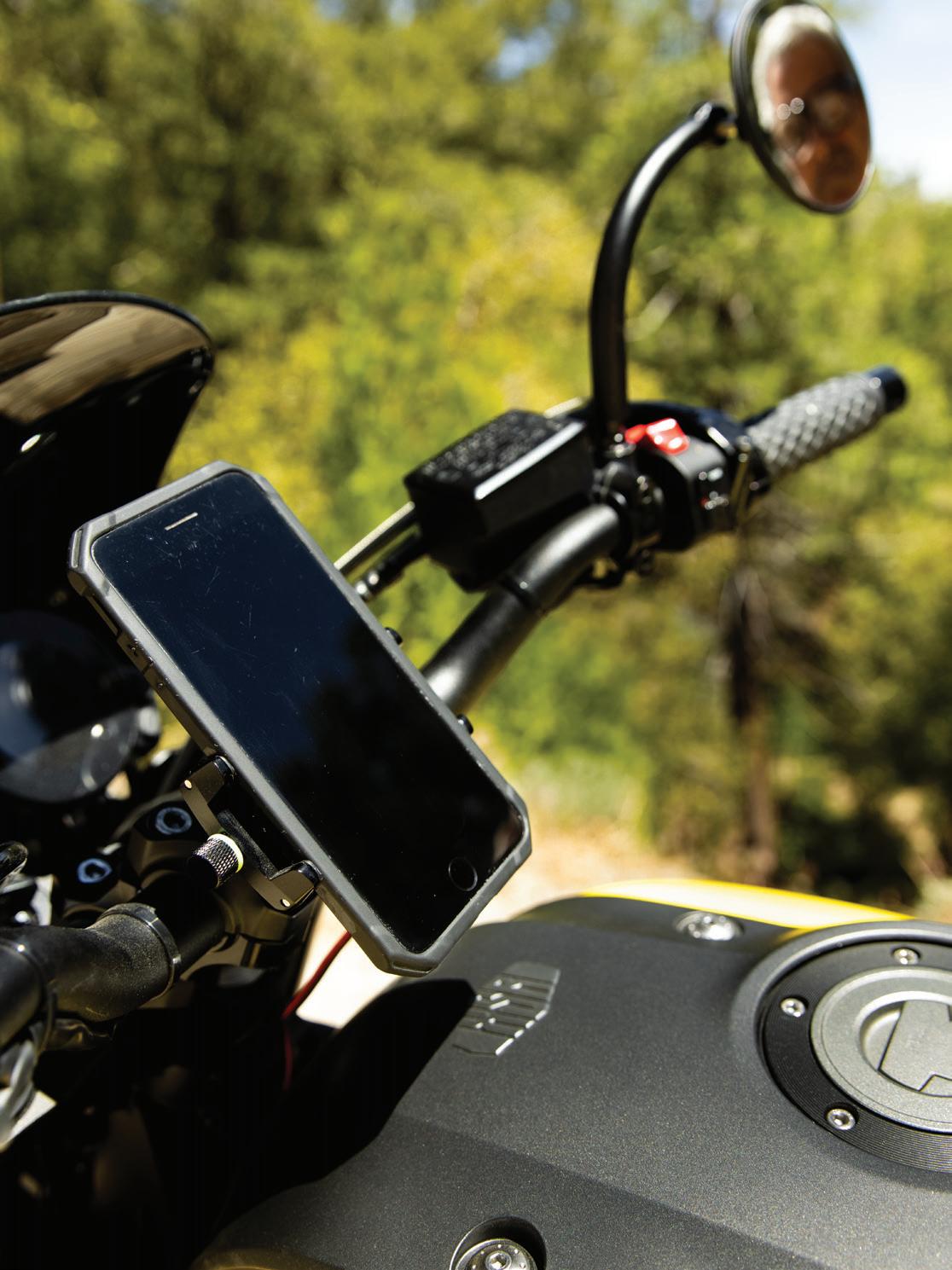
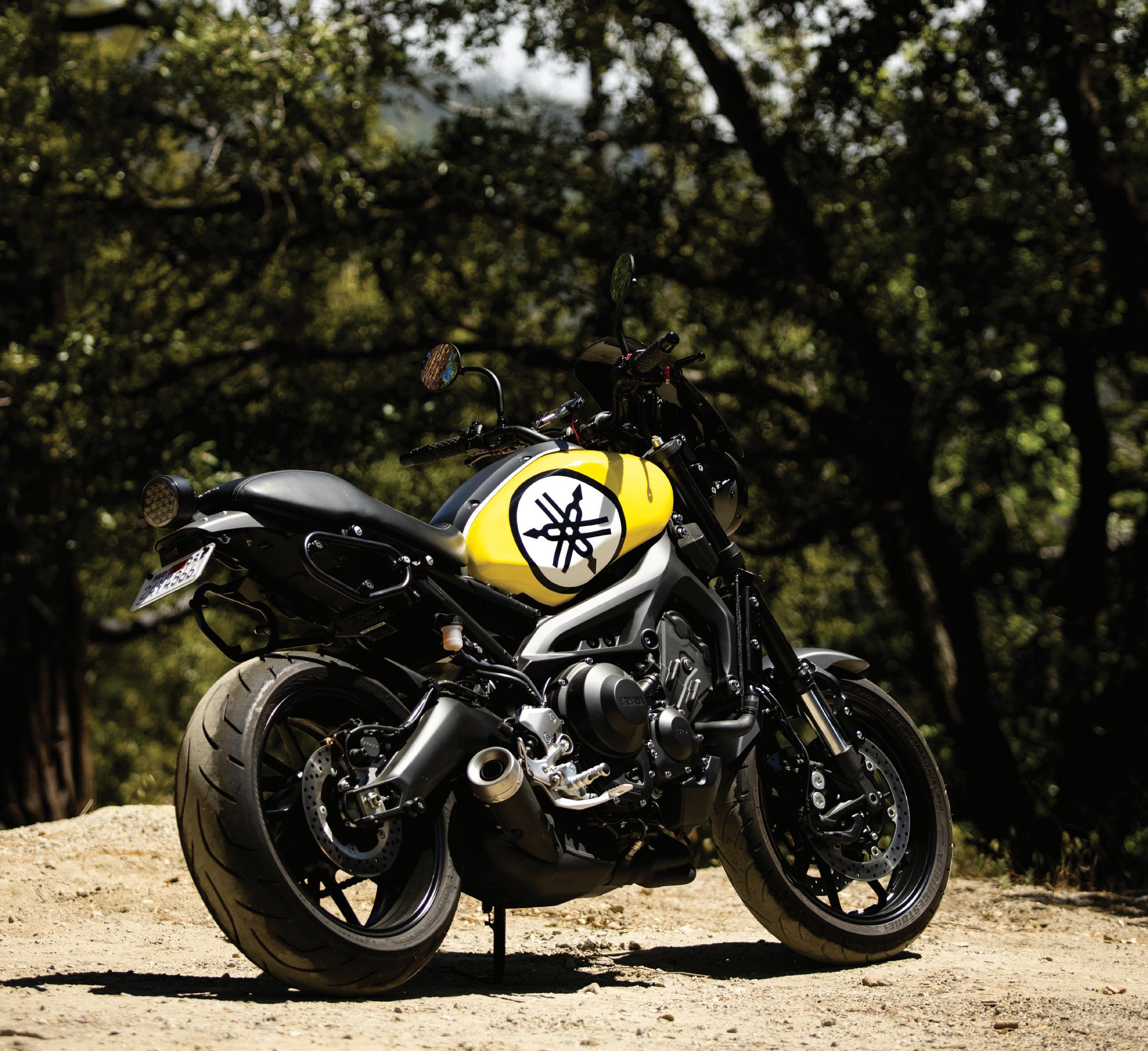
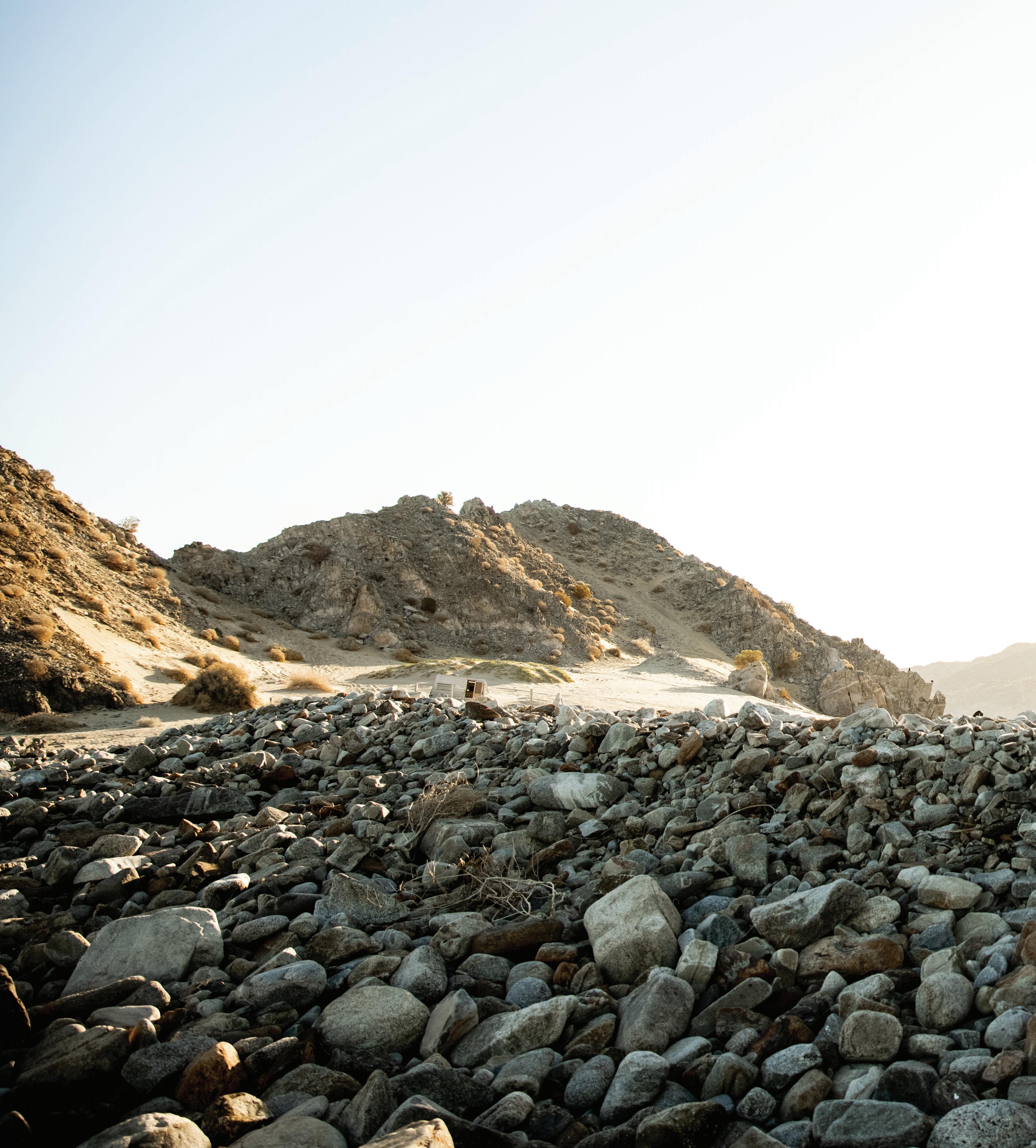
In 2019 I was making reservations for a ferry trip from Washington to Alaska so the Biltwell gang could ride choppers to the Arctic Circle. Easy enough, right? When the nice lady at the reservation center quoted an enormous per-bike cost for the boat ride, I asked how much we could save if the bikes were in a truck. When she said we’d only be charged for the vehicles whose wheels touched the deck, it clicked. The team rolled their eyes when I told them we were going to build a giant, self-contained chase vehicle, but deep in my evil brain I knew it was the right thing to do.
A couple months later, our friends Yeti and Yolo in Montezuma, IA, procured a low-mileage US Army LMTV M1078 troop carrier. This is the rig that replaced the venerable Deuce and a Half that’s ferried troops and supplies all over the world for over half a century. Modernized with a 6.6-liter Cat diesel engine and Allison 7-speed automatic transmission, our LMTV is easier to drive than an old Deuce, and more comfortable too, thanks to its cab-mounted air bags.
Continued on page 55 g
Words by Bill Bryant / Photos by Geoff Kowalchuk
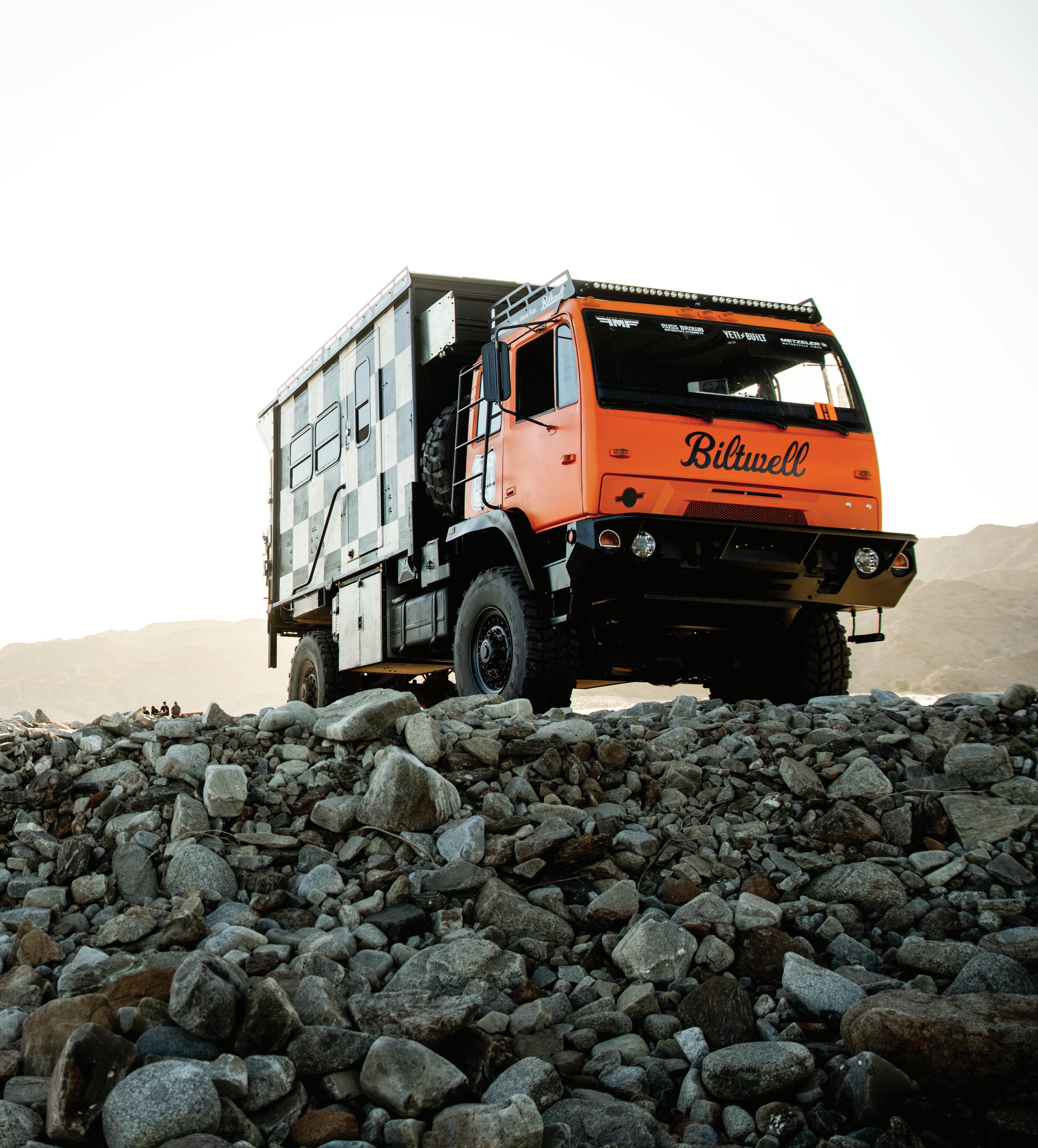

What’s your day job?
Grill jockey and lead fleet service tech at Yeti-Built.

What were you responsible for on this project?
Did this thing’s size make working on it more difficult?
Hunting down a good quality candidate for the build, then de-militarizing the truck, coordinating the composite box and roll-up door build and installation, interior refresh and suspension buildout, then some general service and mechanical preparations.
It’s a huge rig and you’d think that would make things more difficult, but the truth is, it just made things bigger!
Which part of the project did you enjoy most?
Any regrets?
After using it on its first big trip, what’s your favorite part of the LMTV?
When I was jammin’ down dirt roads in Baja behind the wheel of this thing a year after the project started, I’m stoked how a silly conversation with the guys at Biltwell went from “What if?” to “Oh shit!” The lesson I learned is even BIG dumb ideas can become a reality with a little hard work.
My biggest regret about this project is that I don’t get to drive this beast every day.
My favorite aspect of this build after getting a ton of seat time on our last adventure is the overall drivability and capability of this machine.
The Snomaster CL80 12v fridge is a total game changer. We kept beer and sodas on ice in another cooler and kept the perishable food in this glorious contraption. It drew a lot less power than expected and worked flawlessly. Above the slide out fridge is a pantry shelf that gobbled up a ton of canned food, tortillas, fruit and veggies.

Inside the camp box is a modular set up based on E-track. With this design, we can install any number of custom made cots to sleep on or stash gear. We slid kayaks over the top beam in this photo for easy transportation of the usually awkward boats. The E-track continues around the perimeter inside, about a foot off the floor, for lashing down motorcycles.
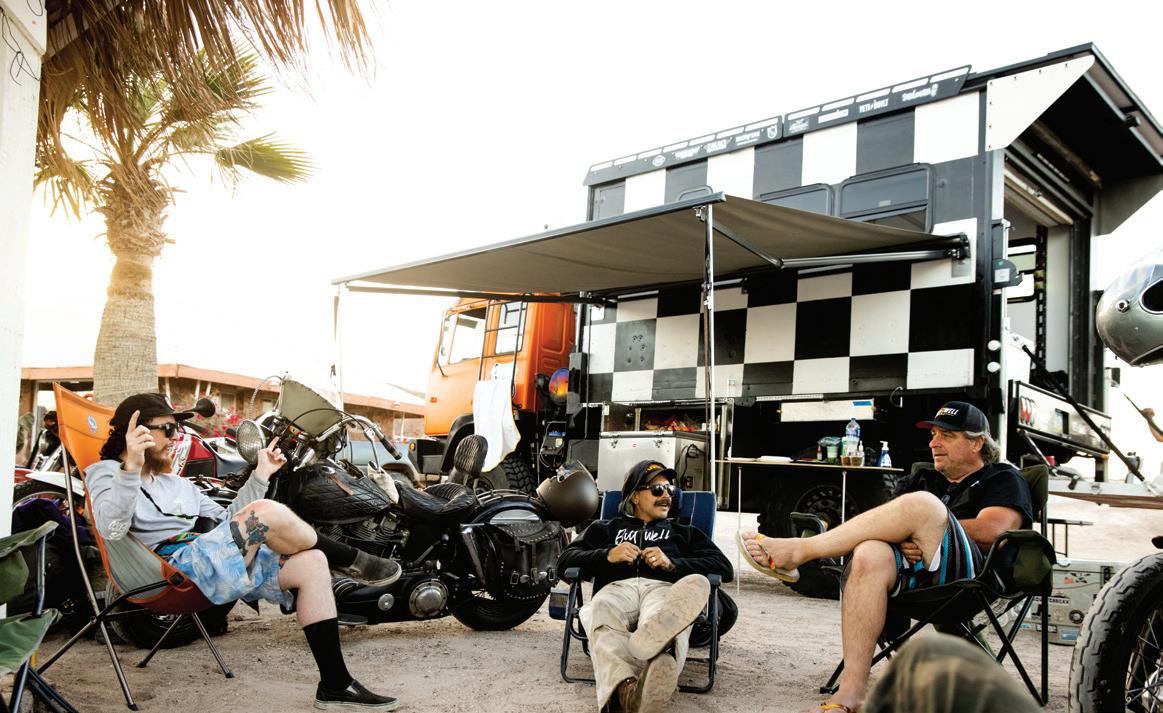
The awning is a cheap RV take-off that we modified to make more rugged. The windows on habitat were also inexpensive RV store items and pop open all the way for maximum ventilation when stopped. Just storing ten camp chairs is a chore with any other rig. We just toss them into the huge gyspy rack above and behind the cab.
“it's basically a 20,000lb chopper.” -JOSH
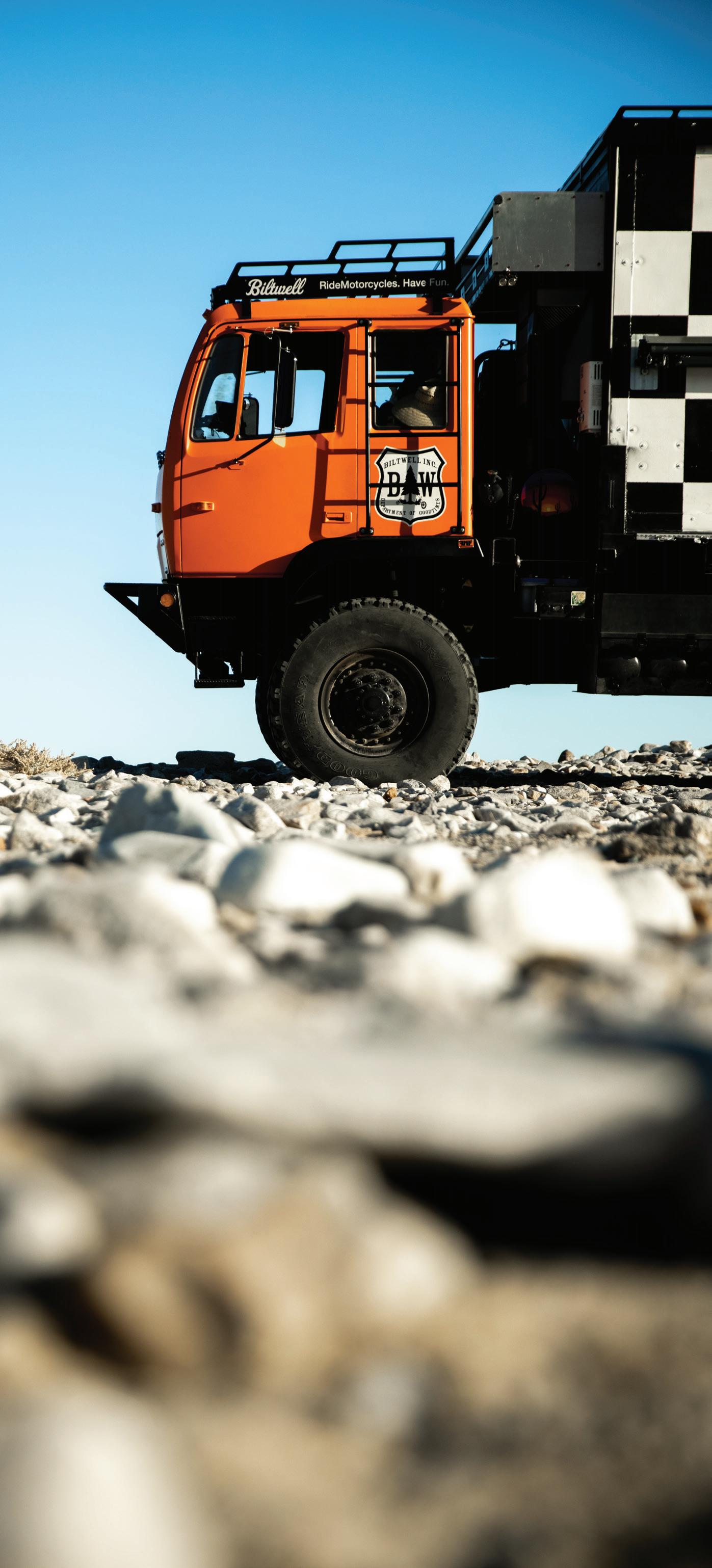

What’s your day job?
What were you responsible for on this project?
I’m a custom fabricator.
I modified the LMTV to accommodate all of the needs for a chase vehicle. Those installs and upgrades included storage boxes for tools; a refrigerator; the welder and generator; and building and installing stairs, windows, a roof rack, water storage, shower, and ladders. Also, I helped with the cool checkered paint job!
After handling the first round of major modifications solo, JD Sansaver and I flew to Iowa to lend Yeti a few more helping hands. Tasks that week included situating the truck’s box, rebuilding the air brake system, and sussing dozens of other odds and ends. Anything that wasn’t mission-critical was sold off or tossed. Yeti installed a Tommy Lift and mini roll-up garage door on the box to make loading bikes easier. In down position the lift gate acts like an aluminum deck to hold a couple more bikes in a pinch. We won’t go far in that configuration, but it’ll save us big bucks when it’s sailing to Alaska.
After spending a year at Yeti’s compound, we drove the LMTV back to Flying Monkey Fab in SoCal so JD could work on it. JD cranked out a long list of to-do’s, not least of which included installing a fridge, mounting a welder and generator under the frame rails, adding pop-out windows on the box, and building a massive roof deck. I designed the laser-cut roof rack over the cab and side rails for the box, which we had powder coated for durability. Other tweaks while the truck was at FMF include the front bumper that doubles as a buffet table, and the most magical slide-out staircase anyone will ever see.
It’s huge. Did that make things more difficult?
Which part of the project did you enjoy the most? (or are most proud of?
Least favorite?
After using it on this first big trip, what’s your favorite aspect of the build?
Yes! My knees were sore from climbing up and down a ladder!
The undercarriage storage boxes and the slide-out ladder are pretty cool.
Having to give it back! I had a lot of fun on this job!
Watching the Circle of Death on the EDR from the deck on the roof was pretty awesome.

“as our dumb ideas go, this is the biggest so far.” -otto

What’s your day job?
That’s a tricky question. To put it simply, I’m a full-time sarfing (Rouserspeak for “surfing”) expat who lives in Panama with a part-time job as the mechanic and video personality at Biltwell. The commute is rough!
specifications:
Model: M1078
Engine: Caterpillar 3115 turbo diesel, 6-Cylinder, 6.6L
Transmission: Allison 7-Speed MD3070PT
Tire Size: 47”
Suspension: Icon
Sleeps: 6 but depends on configuration
Height: 150”
Width: 96”
Length: 272”
Weight: 16, 499 as bare cab and chassis
Max speed: 60mph
What were you responsible for on this project?
It’s huge. Did that make things more difficult?
I was tasked with most of the electrical addons as well as a few other things like roof vents, exterior D-track, fire extinguishers, etc.
Its size didn’t make working on the LMTV more difficult, but it definitely made it more time-consuming. Up and down ladders, in and out of the rear box using the lift gate, crawling around the CAT diesel engine to run wiring. I found myself paying more attention to what tools and equipment I would need before climbing all over the rig to start a new project.
Add-ons: Snomaster fridge, K&N LED lights and pre runner rear light, back up camera, tool boxes, Honda generator, Miller diversion 180 welder, Tommy Lift hydraulic gate, CTIS delete, rally vents on roof, GPS speedometer, loudspeaker/siren, 3 roof racks, cup holders and loads of other stuff from www.eriksmilitarysurplus.com
Which part of the project did you enjoy the most? (or are most proud of?
I love having a PA system in my personal rig, so when I was tasked to install one in the LMTV I was stoked. It’s the same PA/horn system that emergency vehicles use. The horn is loud and distinct, a real attentiongetter. Same with the PA—it’s neat to be able to yell, “Get out of the way!” from inside the cab and being heard over every car and motorcycle in the vicinity.
Least favorite?
Oh man, I must have burned over eight hours just drilling holes through 1/4-inch steel all over the rig. Any time I needed to install a rivnut, mount something, or make an access hole I was having to drill for what seemed like hours. I probably resharpened drill bits more than two dozen times in a two-month work session. My wrists hurt just thinking about it!

We normally outrun the Pig on the highway but on a silty baja backroad, this thing is right at home and ready to work.
The mission?
• Have room for a couple bikes without a trailer
After using it on this first big trip, what’s your favorite aspect of the build?
The fact that we completed our first mission with great success. The LMTV did everything we asked from it. It kept our food cold, our gear dry, all tools ready for action, and provided shade in the Baja sun. My most memorable moment was when I pulled out the welder, fired up the generator, and repaired Geoff’s Dyna on the side of a dirt road. We never skipped a beat on Operation Tranquillo, and a major part of that was due to the LMTV.

• Sleep a few bodies depending on the conditions
• Provide work space for fixing bikes
• Haul food and supplies for a dozen people
• Become a mobile kitchen for small group
• Represent Biltwell at events of all kinds

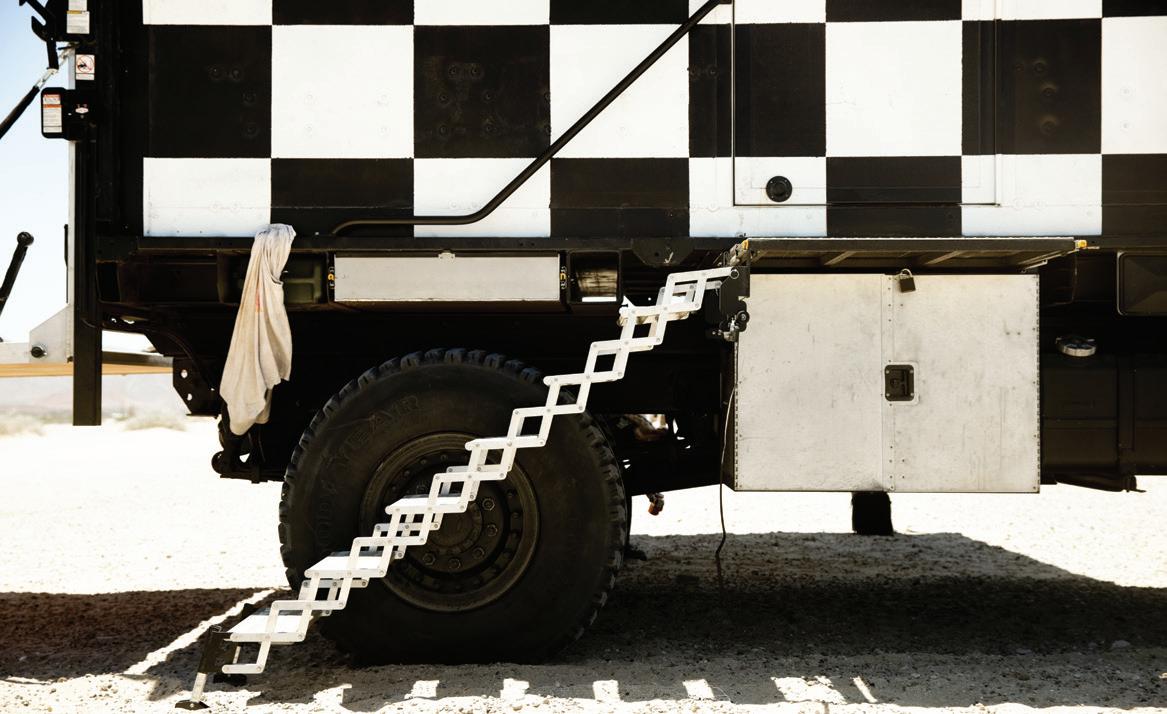

When JD was done, the rig came back to the Biltwell tree fort in Temecula just in time for Rouser to show up from Panama. Rob’s hit list included pulling miles of wire for lighting and charging, and finalizing dozens of electromechanical functions and upgrades. I built a little .30-cal ammo can into a locking fuse box/master switch/ USB station that’s linked to two 12-volt batteries to run all “house” functions. Those batteries are charged by the dual alternator that also sends juice to the bank of 24-volt batteries that start the diesel engine. On one last slam before this year’s El Diablo Run, the team and I created awning supports, braced the mirrors, and stickered it all up with help from Biltwell ops manager BF Josh. With nothing left to do and everything to prove, we took our LMTV on its second official adventure: a 250-mile drive through the Mojave Desert for the Biltwell 100.
Ten miles out from Biltwell HQ, the LMTV blew an oil line. Two hours later, we had found and fixed the 20-dollar part and hauled ass—top speed on this beast is a steady 56mph—to Ridgecrest, CA, in the heart of the SoCal desert. The rest of the trip was hassle-free. A slow leak from a cracked timing cover will make sure the LMTV’s undercarriage never rusts, and we’ll just keep checking the oil and topping off as needed. On the EDR shakedown to Baja and back a few weeks later, the LMTV was flawless, and that trip included cooking, camping, and roadside motorcycle repair for a dozen people over ten days.
It was luxurious to be off the grid with ten bikes and have all the food, tools, parts, equipment, and cold beer we needed to sustain everyone. Inside the box, kayaks fit on the modular cot system JD designed perfectly. We used the LMTV’s roll-out shade and on-board air compressor to quickly repair primary belts on two choppers that were eaten by shortcuts across the Mexican desert. The front bumper/buffet station and adjustable Tommy Lift made food prep and serve easy.
Just like the choppers we built this thing to transport, the Biltwell LMTV will always need some work, and the list of upgrades will likely never end. As for our Alaska adventure by ferryboat, COVID killed those plans last year, but we’ll give it another try in 2022… with as many motorcycles as our loveable beast can handle.
“if 10-year old me designed the ultimate truck, this would be it.”
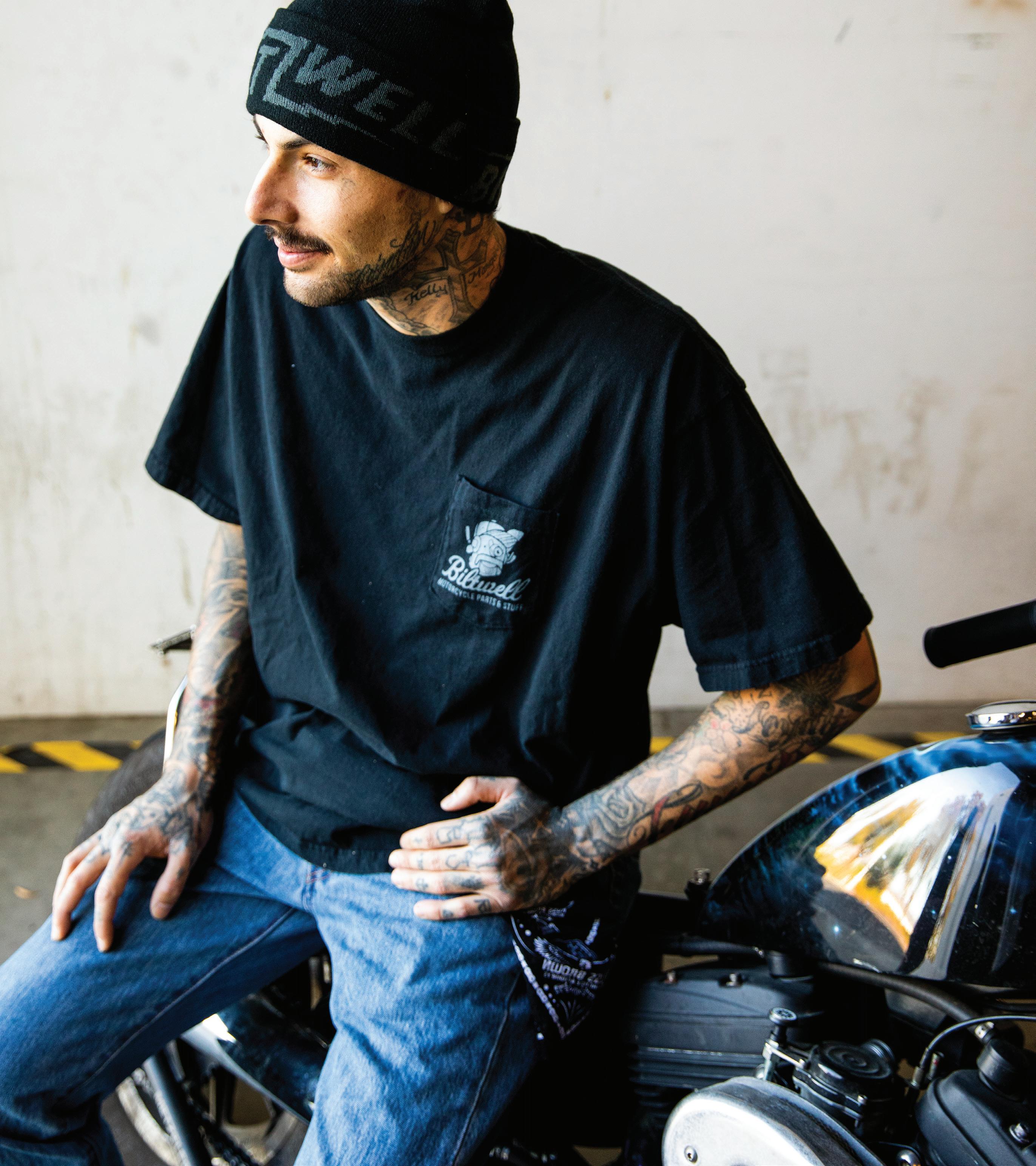
Biltwell helmets are stylish and comfortable—why would our hats and beanies be any different? Making stuff for your head is what we do. Sweating fit, form, and quality like our lives depend on it. We dig making this stuff even more than than you seem to like wearing it, and that’s saying something—we see a lot Biltwell hats hanging off belt loops and sissy bars when we ride down the highway. To everyone who covers their dome in a Biltwell skid lid or hat, thanks for your support.

Cotton twill construction with edge-to-edge sublimated Geoff Kowalchuk photo of Chris “Mad Dog” Moeller racing the Frijole in Baja. Red contrast panel on bottom of curved bill. Woven Biltwell tag on snap tab confirms the goods are legit.

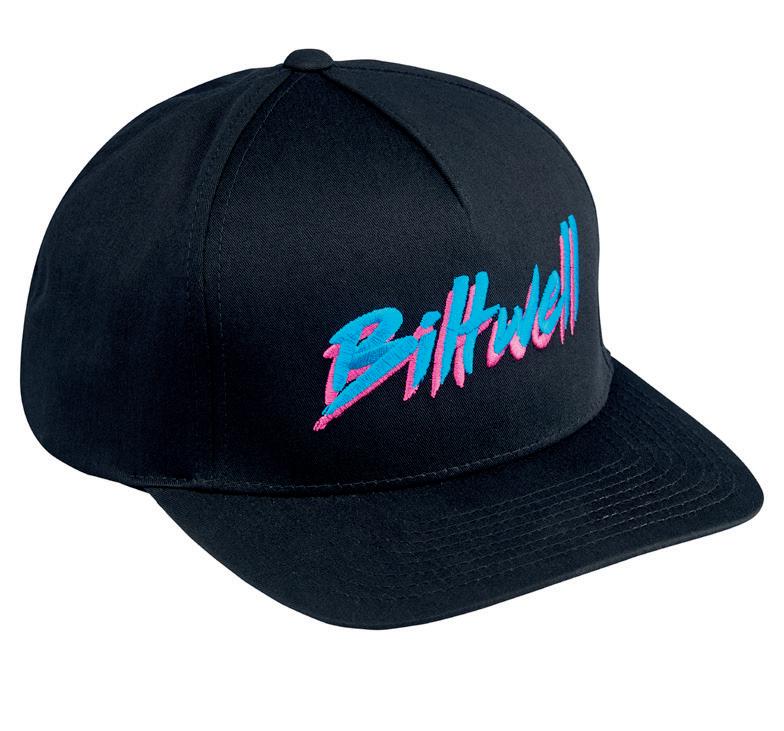
Kickstart your heart in this magenta, black, and cyan #1 hit. Full cotton twill construction on crown and bill, screenprinted checkerboard bottom for maximum metal attitude. Flyin’ V guitar sold separately.
An all-time classic built on one of the best blanks available. Flat bill with contrasting tan cotton twill on the underside. Screenprinted graphic. Embroidered Biltwell tag on snapback tabs. Ventilated mesh back for OG trucker style.

Biltwell—is it a motorcycle parts company, or a bait shop? The embroidered trout on the front of this unit ain’t saying. Mesh back, cotton bill with turquoise underside, and adjustable snap tabs with embroidered tag.

The lightning bolt logo that sees heavy rotation on all three of our new gloves makes an encore on this hat. We use an all-black version of our Best Blank Ever to create this banger, then give it Biltwell stink with tight twocolor embroidery.
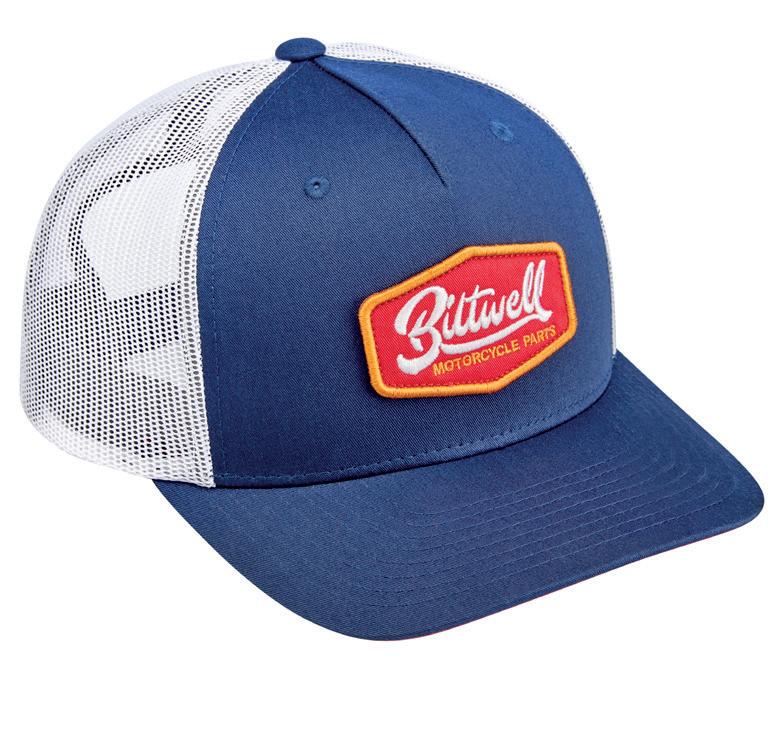
Another classic trucker jawn, this one in blue and white cotton twill/poly mesh livery with a red, white, and gold embroidered patch. An embroidered tag details the snap tabs. One size fits most.
Regardless of graphic application or color, every Biltwell beanie features a tight synthetic weave and perfect blend of insultation and elasticity for one-size-fits-all comfort. We’ll vouch for the warmth and coziness of these babies in anything below Arctic conditions.
Pulling one on in the dog days of summer is your call.

Tone-on-tone embroidery on the olive drab crown keeps the look of this vented mesh/cotton twill trucker hat classy, something you’ll appreciate when it’s time to park the scoot and shoot your Tinder mug.




In a Top-30 list that spurred controversy and contempt, an online magazine once called Ricky Johnson the third-greatest American motocrosser of all-time. After spending one day with the man, I’ll go out on a limb and say RJ’s the GOAT of not caring what bloggers think. That makes him #1 in my book.
By Harold McGruther
Photos by Scott Cox & Geoff Kowalchuk
In the weeks leading up to their assault on the NORRA 1000 in 2018, Team Biltwell riders Bill Bryant and Erik Westergaard were at a swap meet with their Frijole XL883 on display. Commentary from the peanut gallery is standard fare at these soirees, but the frothy stream of verbal diarrhea reaches FEMA levels of suffering when there’s a Harley desert sled under your EZ-Up. Bill’s patience for tire kickers and looky-loos was already razor-thin when a fit, grey-haired man approached the Biltwell booth.
“Who’s riding this thing?”
“We are,” Bill replied.
“Well, you gotta fuckin’ be patient. Guys are gonna be disintegrating all around you, and you’re gonna think you’re going backwards, but you’ll be OK if you take your time. There’s a water crossing outside Loreto—DON’T be a hero and try to wheelie that thing. Get off, look around, see where the guys ahead of you are going. Look for tracks on the other side—that’s a sign it’s shallow enough to cross without taking on water.”
“Yeah… thanks,” Bill nodded, visibly unimpressed with the old timer’s advice.
Sensing tension, the affable gent said good-bye and walked away.
“Who the hell was that guy?” Bill asked. “Ricky Johnson,” Westy replied.
“The Ricky Johnson?” “Yup.”
If you grew up on dirt bikes in the ‘80s as Westy did, Ricky Johnson is a household name. Everyone who doesn’t follow American motocross—or anyone who came to two wheels on pavement—can be forgiven for
not recognizing the seven-time AMA National Champ. In his prime during the Golden Age of American motocross, The Bad Boy earned six of those #1 plates in a three-year span from ’86 to ’88, dominating fellow champions like Bob Hannah, David Bailey, Mark Barnett, Jeff Ward, Johnny O’Mara, and Micky Diamond in the process.
After eclipsing Bob Hannah’s all-time supercross win record in February of 1989 during a dominant fiverace winning streak, the Honda factory pilot headed to Gainesville, FL, to start his outdoor season. A fluke altercation during practice saw Danny Storbeck’s front wheel auger into RJ’s elbow, driving the bones of his forearm into his hand with enough force to shatter his right wrist and several bones in his throttle hand. He would return to Gatorback the following season to win another outdoor national, but six doctors concurred Ricky Johnson’s motocross career was over. At the Daytona Supercross in 1991, RJ announced his retirement. He was 26 years old. How he got there—and what he did next—is why Ricky Johnson is legendary. This is his story.
Like so many MX champions before and after him, Johnson got his start on minibikes. Local TT races at first, but by nine he was racing motocross. “I lost my first race,” Ricky recalls with a wry smile. When he was 12, RJ rode a 125 for the first time. Sensing his son’s potential but unable to reconcile the high cost of maintaining two bikes, Mr. Johnson asked his son to make a choice. “I picked the 125. I went from 125 beginner to pro in three months.”
“How does that happen?” I asked incredulously. “I was riding buddies with Broc Glover, who just signed with Yamaha. We were at a local spot in El Cajon and Broc let me ride his practice bike. I asked Broc if I could race it and he said yes, but that I couldn’t tell ANYONE. We went to Carlsbad and I signed up in 125 junior class. I’m 12 years old, standing on
“I did most of my practicing with grown men, so when I bumped their kids in turns, it wasn’t pretty.”
a YZ100 racing 125 intermediates, but people protested me because they said my bike was smaller and quicker than everyone else’s.” When he turned 16 in 1980, Ricky entered his first AMA pro race —the San Diego Supercross. Ricky didn’t make the main, but fondly remembers battling 3-time AMA champ Marty Smith and 5-time FIM World Champion Georges Jobe in the LCQ.
In 1981, 17-year-old RJ contested the entire AMA 125 national circuit with factory support from Yamaha. At the last race of the season, Ricky won the second moto at the legendary Carlsbad Raceway. Young Johnson’s heroics in front of his hometown crowd were enough to earn him seventh overall in the championship, and AMA 125 Rookie of The Year honors. The Bad Boy had arrived.
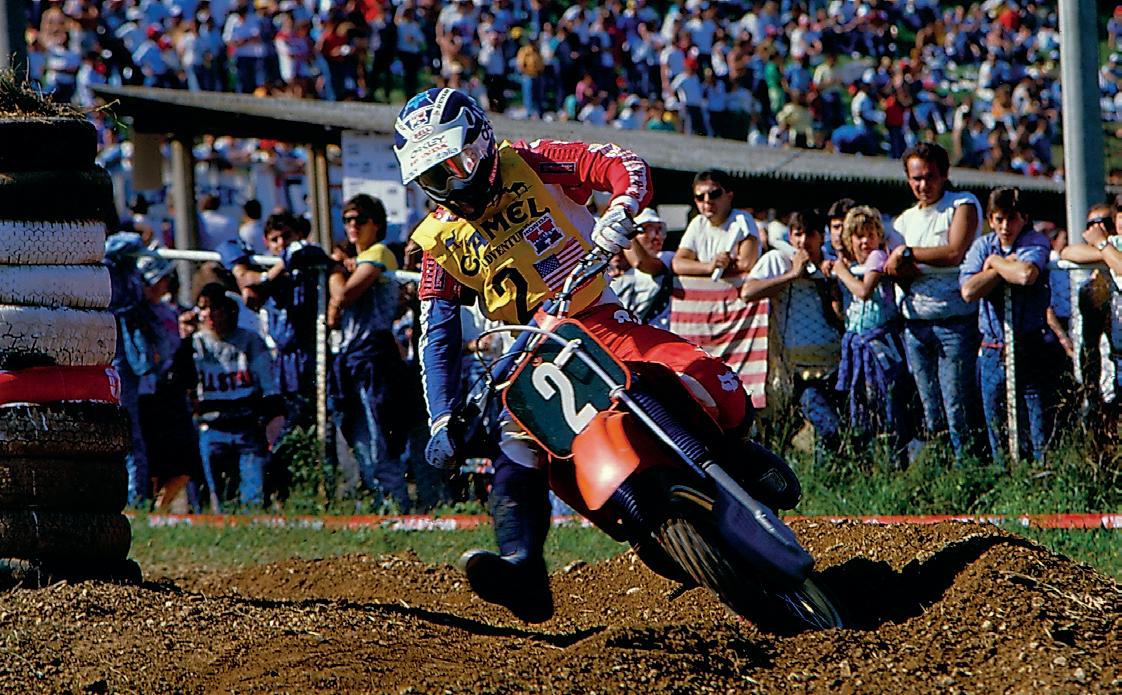
the milk crate on the starting line, the whole bit. I finished mid-pack, but I had a blast. Unfortunately, the parents of a lot of kids wanted to fight my dad because I rode so aggressively. I did most of my practicing with grown men, so when I bumped their kids in turns, it wasn’t pretty. When you grow up leaning on 25-year-olds, the 12-year-olds go flying. When I turned pro it was even worse. On a good night at a local track, I could walk away with five hundred bucks. When you’re a 13-year-old kid taking away a grown man’s food money, he will fuck you up.”
Because sixteen is the minimum age limit in AMA pro racing, Ricky spent four years racing local pro events at non-AMA-sanctioned tracks throughout California, sometimes three classes per track and three tracks per week. “At one of my last amateur races Broc got me a test on Yamaha’s brand-new YZ100, their big-wheeled mini. I destroyed everyone on that thing. I won my second junior race, then like three in a row, so they moved me to intermediate. Now I’m a 12-year-old kid on
According to Racer X magazine, no one epitomizes the American motocross superstar better than Ricky Johnson. RJ’s work ethic, racecraft, gift of gab, and surfer boy’s good looks made Ricky a quadruple threat, and every marketing and team manager’s dream. Regarding his own dreams in those days, Ricky’s vision is crystal clear: “I wanted to make a million dollars— everyone I raced wanted to make a million dollars. We were convinced with a million bucks in the bank we could live off the interest the rest of our lives.” Ricky learned quick that getting good sponsors to pay big money was easy when he was winning. “Bell, Oakley, Fox… I’d get on the cover of Cycle News and these guys were psyched. Kawasaki had been courting me all year in ‘86, so I was pissed when they signed my ex-teammate Ron Lechien at the last minute, and I let ‘em know it. (Kawasaki team manager) Roy Turner called me and I told him, ‘I know you signed Ronnie, and that was a mistake. I’m gonna kick your guy’s ass.’ Yamaha was ready to pay me 225 grand for the next year and I was gonna sign the contract on Wednesday. On Tuesday night, Roger DeCoster called to ask me if I’d be interested in riding for Honda. I told him yeah, but only if I could ride one first.” DeCoster obliged the reigning Supercross and 250 MX champ by meeting RJ at a practice track with recently fired Ron Lechien’s works Honda and a suspension engineer. “Tano re-valved the shock, I raised the handlebars two millimeters and adjusted the levers a couple mill and—
bam!—five seconds a lap faster than my Yamaha.” Ricky was sold on Big Red. Now all he needed was a contract.
What Johnson accomplished during contract negotiations with DeCoster at Honda was a masterclass in creative financing, but came at a price. “The money was crazy. My parents were running Ricky Johnson Incorporated at the time, and they’d never seen anything like it. Good base salary, hundred-thousand-dollar bonuses for every championship, contingencies for every podium at nationals, supercross and GPs, you name it. Plus, every time I won a championship, my salary would go up 50k the following year. Same with Fox, Alpinestars and the rest of ‘em.” Like so many other small, profitable family-owned businesses, the monster that RJ’s racing career had become “created a rift between me and my dad until the day he died,” Ricky laments. “I’d call him after getting second at a national and he’d holler, ‘You know how much fuckin’ money you lost? This much from Bell, that much from the other guys…’ yeah, I know dad. Eventually I had to make a break from my parents on the business side….” Ricky’s voice trails off and his thoughts appear to wander. “…things got complicated.”
Continued on page 65




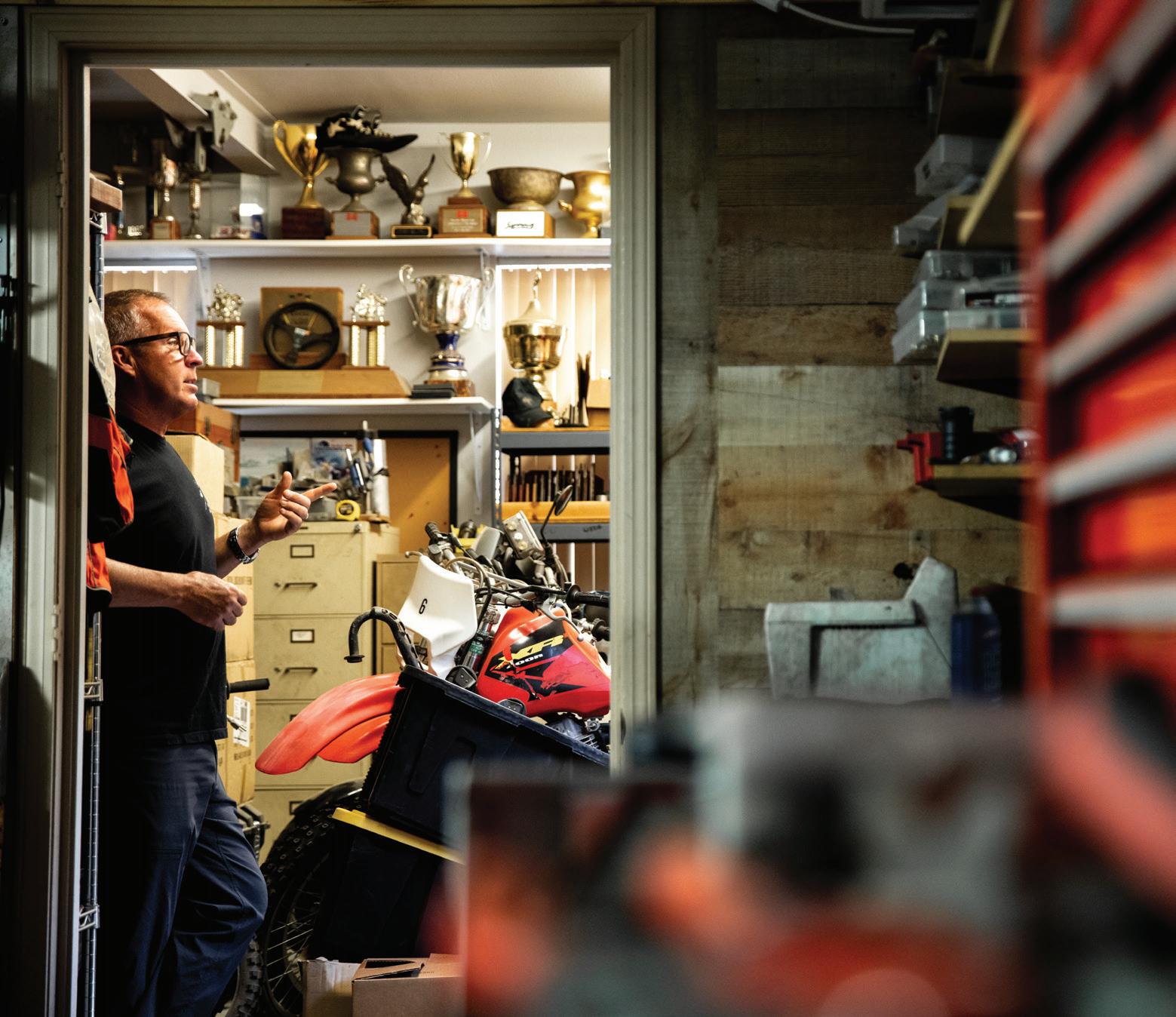
“I’m still racing trucks. I’m racing cars, getting paid for TV commercials. I have eight hustles, and all of them are fun.”
Brand collaborations these days are common as Instagram influencers, but were unheard of when Ricky Johnson was racing at the front of the global motocross pack. When I floated the notion that he may have unwittingly given birth to the modern collab when he convinced his streetwear sponsor and racing gear supplier to combine forces, Ricky couldn’t name anyone who beat him to it. Like every other hustle in RJ’s career, this one offered lessons in business they don’t give you in MBA school.
In 1984 Ricky met Mark and Brian Simo at an AMA national in Florida. The Simo brothers were peddling baggy shorts called Life’s A Beach out of a U-Haul trailer for 20 bucks a pair. Ricky dug the guys’ style and talked them out of some shorts for himself and his teammate Broc Glover. Sensing an opportunity to pay back the brothers’ generosity, RJ asked his Team Yamaha manager if he could wear a pair of turquoise tiger print boardshorts over his racing gear. “Kenny told me if I won the first moto I could do whatever the hell I wanted.” After getting a lesson in guerilla marketing from Ricky Johnson that resulted in selling every stitch of inventory in one day, the Chicago natives moved to California and set up shop in Carlsbad. Things ignited quickly, with offshoots Too Hip—an RJ-driven mail-order business—and an edgier subsidiary called Bad Boy Club rising from the fire. Ricky’s public image personified the Bad Boy brand perfectly, which seemed rooted in good times, all the time. Everyone wanted a seat on the Bad Boy bandwagon, JT Racing—RJ’s new riding gear sponsor— included. After agreeing to a royalty for using Life’s A Beach textile designs on their race gear, JT cranked out collab pants and jerseys faster than RJ could win races. Of course, every cash cow runs out of milk sometime, and the JT/BBC collab was no exception. In its prime, however, JT sold Ricky Johnson signature gear like dildos at an all-women’s prison. That was a good thing for Ricky, because his retirement from pro motocross was just around the corner. When that day came, Ricky Johnson Incorporated had to find a new hustle.
RJ answered without hesitation. “No. I got offers from all of them—Bell, Oakley… I couldn’t do it. I didn’t want to have some douchey kid give me attitude because I woulda smacked him and said, ‘Fuck you!’” Instead, Ricky played to his strengths and did what he’s always done: he hustled. At the Baja 1000, Johnson took wins on two wheels in three different classes. Those heroics caught the attention of prominent racecar builders who helped Ricky land Chevrolet sponsorship and seat time in late-model stockcar and Craftsman truck events in the ‘90s. By the turn of the century, Ricky added ASA Rookie of the Year honors to his resumé, no easy feat when you consider his teammate at Herzog Racing was another phenom from El Cajon: eventual 7-time NASCAR champion Jimmie Johnson (no relation). Another high point on four wheels occurred in 2010 when RJ dethroned defending champ and multi-time Baja winner Rob MacCachren to take the 2010 TORC Pro2WD series championship.
Before meeting Ricky at his son’s fab shop for this interview, I asked Bill if he had any questions for the helpful stranger who told him how to finish the NORRA 1000 in 2018. “Yeah—ask him what’s the secret for making a living in motorsports for 40 years— that’s something anyone who rides motorcycles would love to know.”

How do you know you’ve made it? When you can pack your lunch in your very own lunchbox
As was the case with every rapid-fire exchange during our nearly two-hour bench racing session, RJ’s response was clear, blunt, and from the heart.
After dominating motocross for the better part of a decade, parlaying that success into a day job would have been a slam dunk for 26-year-old Ricky Johnson. When I asked him if he ever considered that route in retirement,
“Sometimes I think about guys from my era who are now rich as fuck… guys like George Holland, who owns one of the top-10 almond farms in the business, or Chuck Sun, who told me to get into Bitcoin… I didn’t… I’m stupid (laughing). If you asked me that a year ago, I might have said I regret not taking a job for the security, or that I should have paid more attention to the money. But here’s the thing about money: I’ve always figured out how to earn it—that’s how I roll. It’s what I do. I don’t pay bills, I don’t manage accounts, that’s my wife’s job… I don’t want to know about it. I’m better when somebody just gives me a hundred bucks and says, ‘here’s your money for the week.’ Some days I’ll go big and buy a steak, but I’m just as happy with two hamburgers and a water. I don’t care. Would I rather have a shit ton of money in my pocket? Fuck yeah. Would I change what I’ve done to get it? No way. I’m still racing trucks. I’m racing cars, getting paid for TV commercials. I have eight hustles, and all of them are fun. When I look at my life, I’m winning… I’ve won. I’m crushing it.”

Before full-face lids with flip-down shields entered the picture, plenty of motorcyclers were happy to hit the trail with little more than a three-quarter lid and a pair of Ray-Bans. Goggles had their fans in those days, but their vibe was less AMA MX, more WWII. Feature creep and the never-ending quest for market dominance are insidious forces, and can turn things that were once perfectly acceptable into something utterly absurd. Nowhere is this more apparent than with modern motorcycle goggles. What started life in the early ‘70s as a repurposed ski goggle mutated over generations into the galactic blast
shields you see on MX pros today. We’re not sure who started this arms race, but we know where it ends: Joe Lunchbox has to fork over 200 bucks for goggles so Bubba Carmichael and Ricky Trickstar can get paid.
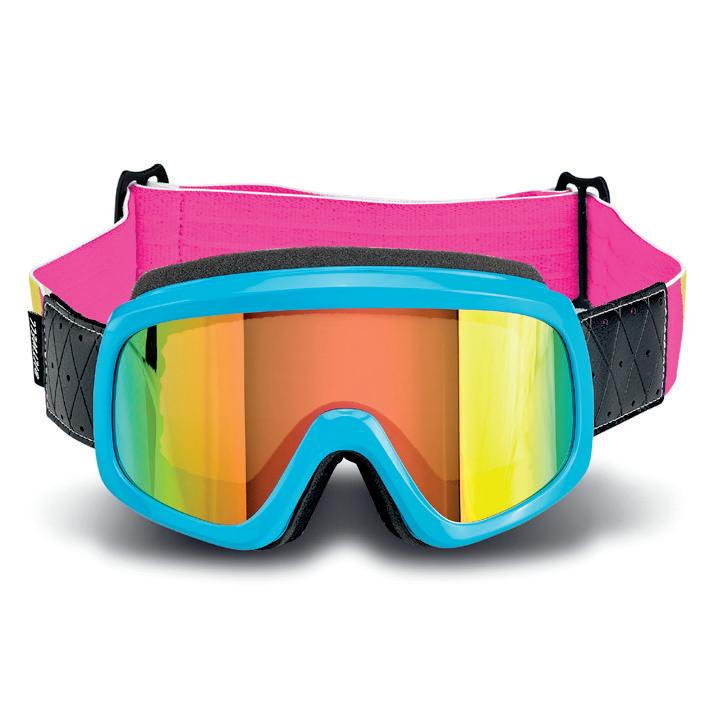
Like every other essential in our riding gear collection, Biltwell goggles offer everything but overkill. By rejecting flash and filigree (we’re looking at you, hologram lens) and using the best materials and optic technologies available, Biltwell Moto and Overland goggles are engineered to protect eyeballs and cashflow.
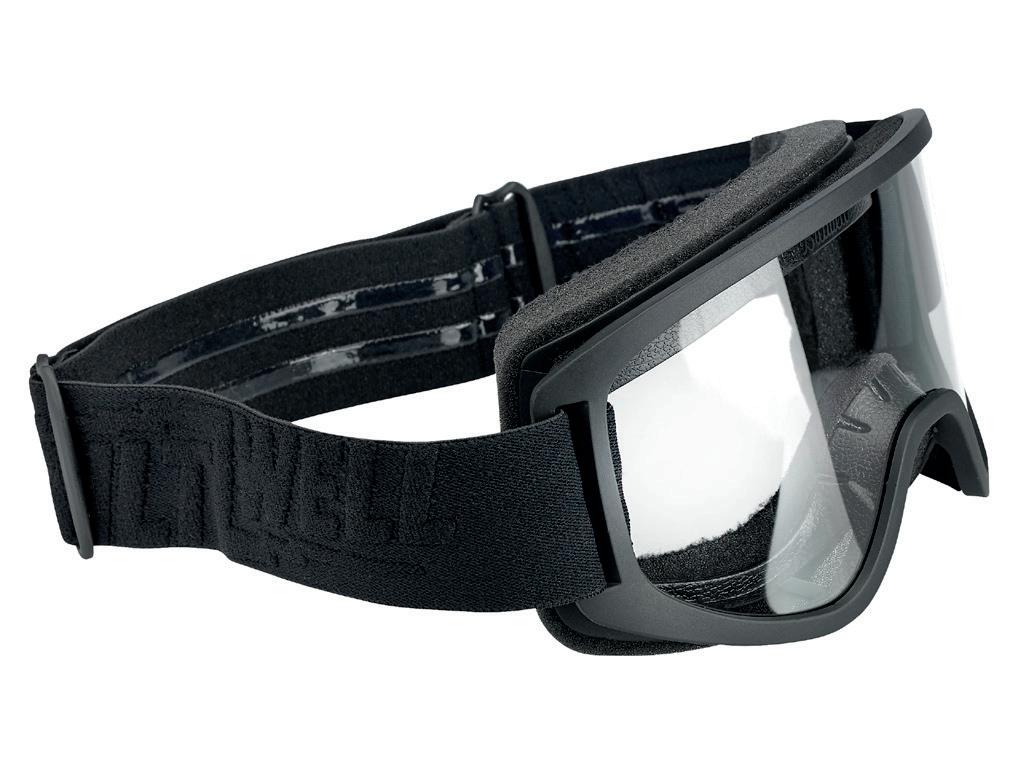
Impact-resistant, CNC laser-cut polycarbonate lens
If you skip drinks and share dessert, 40 bucks might get you and your old man two appetizers and mud pie at Applebee’s. You’ll be full for a couple hours, but your breath will smell like chicken wings. Save yourself the embarrassment and buy a pair of our Moto goggles instead. Nothing deep fried here. What you get for two Andy Jacksons is a low-profile molded polyurethane frame, an adjustable woven strap, and an anti-fog polycarbonate lens to see trails and tarmac ahead of you in crystal clarity.

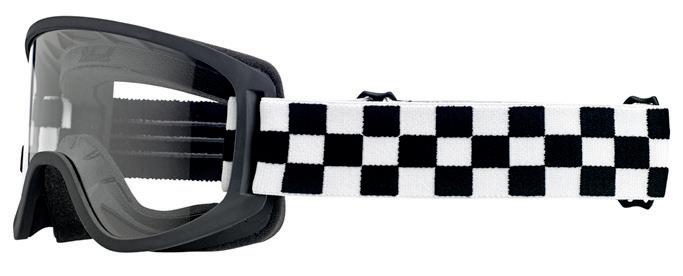


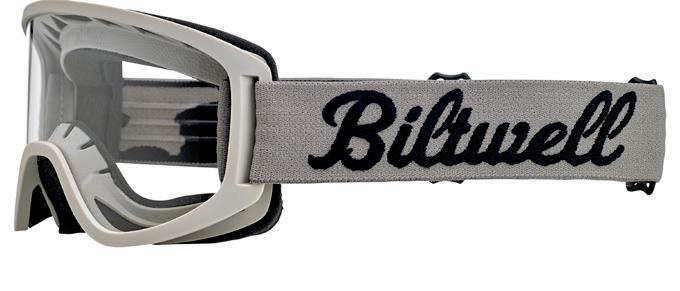
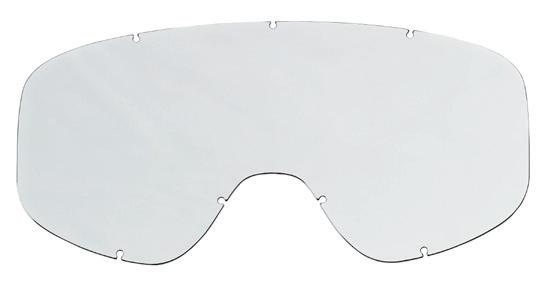
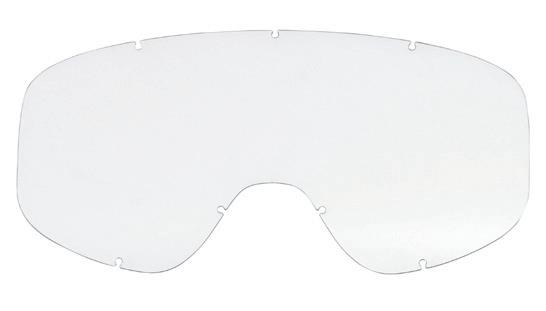



Second clear replacement lens included for safe riding in low-light conditions
Woven elastic strap with double D-rings and anti-slip silicone strips
Soft poly/cotton sack included waith goggles is great for cleaning and storage
3-phase molded eye port padding features quilted fleece Lycra for wicking and filtration

Embossed synthetic leather strap mounts with hand-stitched detailing
Low-profile, injection-molded thermoplastic frame is rugged yet flexible for comfort and durability
Anti-fog lens treatment dissipates moisture build-up on inside lens
Injection-molded, CNC laser-cut polycarbonate lens is super strong and optically precise
Our premium goggle for high-performance riding. Low-profile, injection-molded polyurethane frame features a highly impact-resistant, optically precise polycarbonate lens with anti-fog treatment for maximum protection and visual clarity. Like every Biltwell goggle, Overland’s woven—not screenprinted—strap features anti-slip silicone strips to stay secure on your helmet. Hand-stitched synthetic leather strap mounts feature subtle branding and contrast stitching for a clean retro vibe.



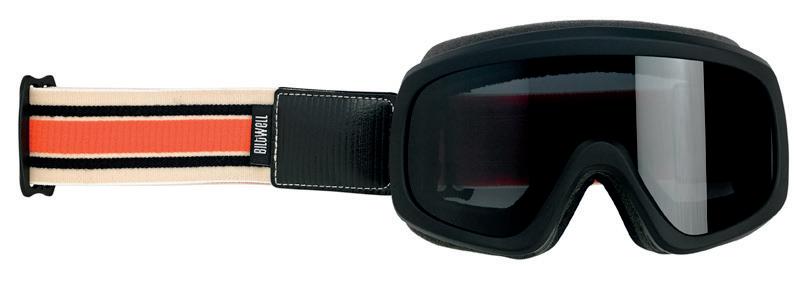

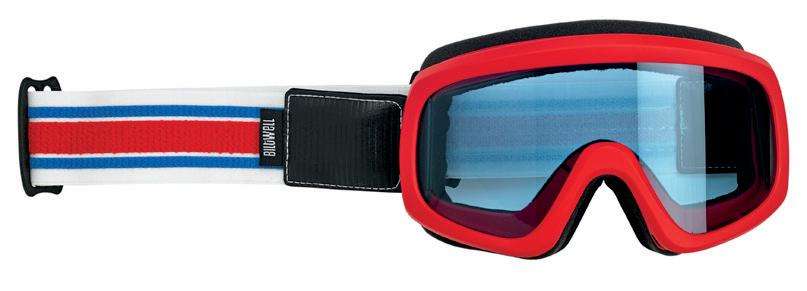



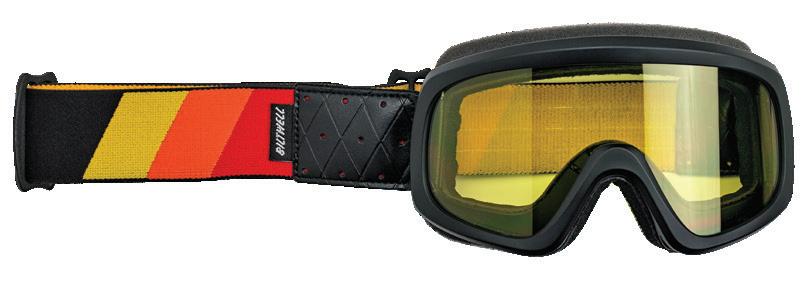

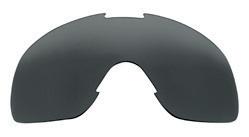
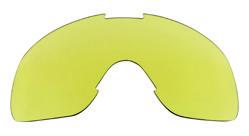
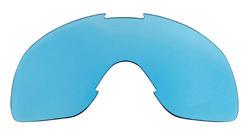


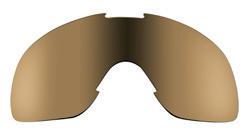
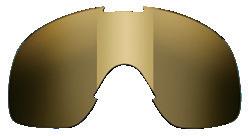
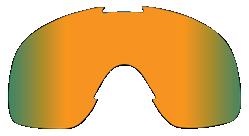

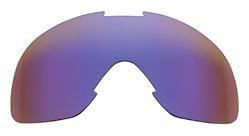



The El Diablo Run isn’t the first motorcycle adventure of its kind, and it won’t be the last. Like most things in life, timing deserves much of the credit for its popularity and success. Remember, Biltwell’s first Mexican motorcycle adventure took root in the scorched earth of made-for-TV chopper drama in the mid-2000s. After a steady diet of theme bikes and build-offs, serious bikeriders were ready for a reset. The El Diablo Run satisfied a new generation’s thirst for fun without the fat. A hard ride made easy by what it lacked: No charge cards, no cover charges, and no

Forty-five men and two women roll into Ruben’s Camp on Mother’s Day

Shit gets WILD on EDR III. A reset is required


EDR founders put their Mexican hell ride on two-year hiatus to run one growing business— Biltwell—and start another: ChopCult.
After a two-year hiatus, EDR IV rises like a phoenix from heavy juice on social media. International attendance reaches an all-time high, with Germany, Holland, Canada and the UK represented
EDR skips a year to become a bi-annual event. This gives builders more time to construct the Diablo chopper of their dreams
Thanks to mainstream media coverage in bike rags worldwide, EDR V sets a new record for attendance, with 350 folks raising hell in Baja
and
for the first time

international border into San Diego. If my big twin kit bike and I survived without going home in Bill’s truck, we passed the test. After a quick stop in Chula Vista to fix a loose ground wire, I motored back home, no worse for wear.
With that trial by fire completed, we hit the Internet to share plans with like-minded motorcycle enthusiasts. Thanks to interest on the message board JockeyJournal.com, 45 men and two women met at a breakfast joint in Old Town Temecula for the first El Diablo Run in 2006. The bikes on that maiden voyage were an eclectic mix of freedom machines— everything from a gaggle of British choppers to a pair of bobbed Ducatis, some rigid Shovels, plenty of Sportsters, and a Knuckle or two. If that armada sounds scattershot, those first bikeriders were an even broader mix. Pilots and barmaids. Skateboarders and BMXers. Photographers and metalworkers. Truck drivers
EDR VII brings the first major format change in a decade: no more ride to Ensenada. San Felipe is the place to party, so we flip the script for three nights at Ruben’s Camp

and pastry chefs. Ad hacks and clergymen. In other words, working stiffs and motorcycle kooks just like you and me.
Just to be clear, Baja is treacherous. Climb into her dusty maw foolish or cocksure and she’ll chew you up like a goat meat taco. Enter with eyes and mind wide open and California’s lazy neighbor will embrace you like a drunk cousin. This is the Baja hundreds of EDR veterans know and love, and the place a new generation of bikeriders dream about.

EDR VIII Citizens of San Felipe shows their appreciation by letting us host the bike show on the main drag overlooking the Sea of Cortez
2,500 bikeriders tear off their Covid masks and make EDR IX the biggest and best ever. 2,500 riders say goodbye to the Circle of Death

Hard-core fans of Baja—natives, visitors and ex-pats alike—share an abiding passion for the place, and will enthusiastically raise a glass to its spirit at the drop of a sombrero. Of course, one question every Baja tourista must ask herself is, “where do I draw the line?” If five beers get you lucky and ten get you arrested, how many to light your hair on fire? Feed feral cats with milk from a lactating stripper? Fry E-D-R on your ass with a branding iron? How many coco locos to tattoo a dick on your chest? Throw a stick of dynamite in your best friend’s tent? These aren’t hazing rituals or urban myths—they’re the stuff El Diablo legends are made of.
You don’t have to be blind drunk or brain damaged to enjoy Baja by motorcycle, but it sure helps. Of course, not everyone on the El Diablo Run is a drunk. Plenty are vegans, teetotalers, military vets, or party clowns. If America is a melting pot, Mexico is a rusty hubcap over a dumpster fire filled with sizzling chunks of mystery meat from Satan’s own carniceria. Folks hungry for adventure don’t ask what’s cooking—they shovel it down with a greasy tortilla and kill the flies with a wedge of lime. When things get too hot to handle, they douse the fire with another cold beer. If that sounds like a recipe for good times, you’ve come to the right cocina.
